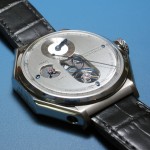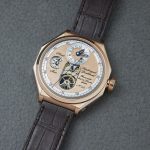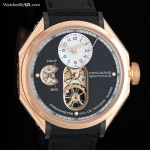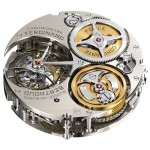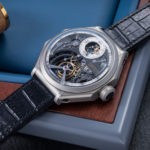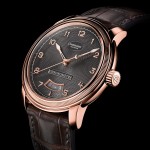In-Depth: Ferdinand Berthoud Chronomètre FB 2RE
Absolutely gorgeous mechanics.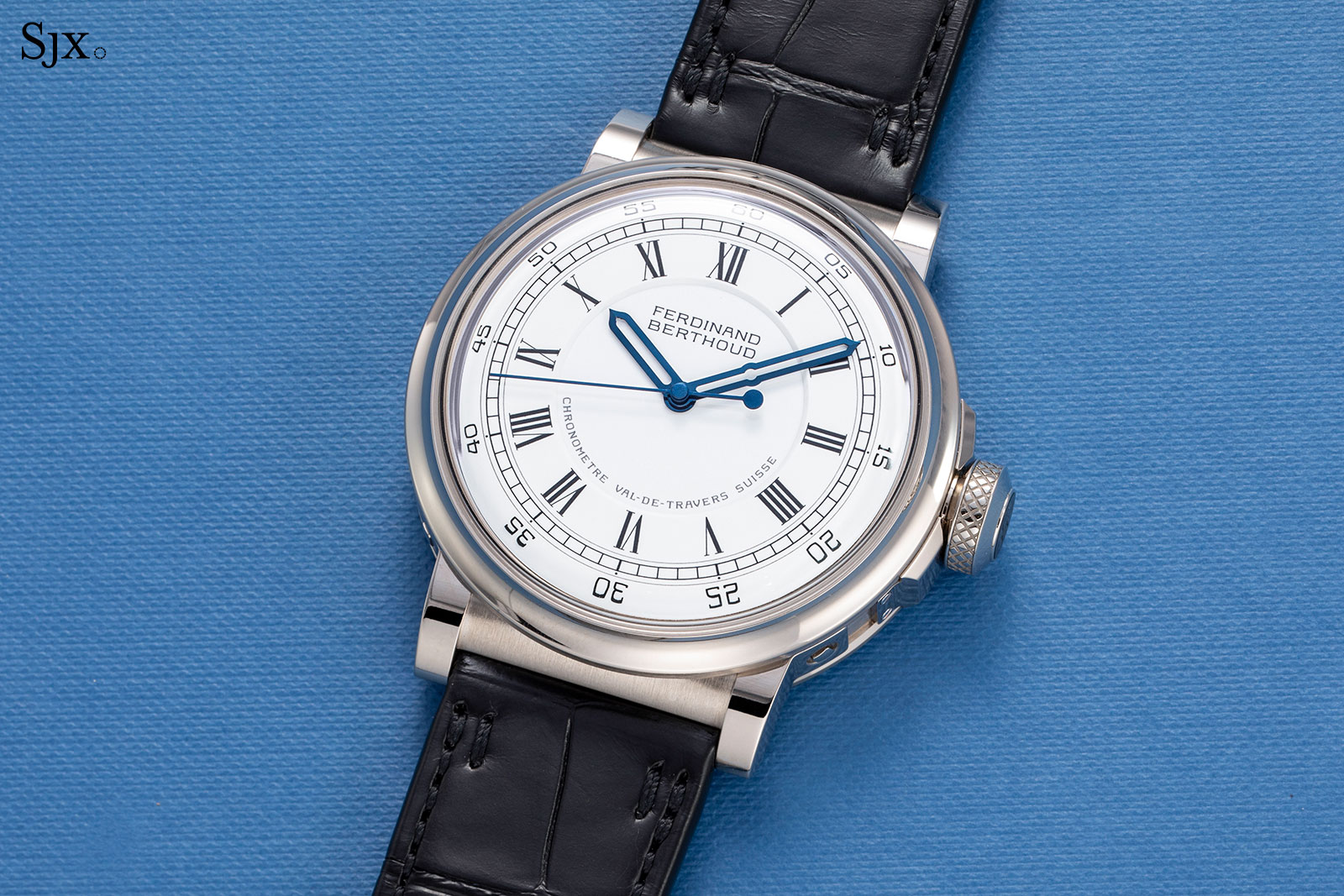
In a year that’s been short on really exciting watches, a contender for watch of the year – or more specifically, movement of the year – has just been unveiled by Ferdinand Berthoud.
Equipped with both a remontoir d’egalite as well as chain and fusee, the Chronomètre FB 2RE is a strikingly impressive example of contemporary watchmaking inspired by the past. More importantly, it features a movement that’s executed to an immensely high standard, one that is just wonderful to look at.
At the same, the round-cased FB 2RE also addresses the primary shortcoming of the earlier Ferdinand Berthoud FB1, namely its odd aesthetics due to the case shape.
Initial thoughts
I have always been impressed by Ferdinand Berthoud watches, though I was never a fan of its octagon case. And based on my conversations with collectors, I was not the only one hoping for a more conventional case shape.
Now it has arrived, and the FB 2RE does not disappoint. I managed to examine the finished watch up close several months ago, and the quality of execution, inside and out, is remarkable. The movement certainly holds its own against the very best of the independent watchmakers, like Greubel Forsey for instance. It is that good.
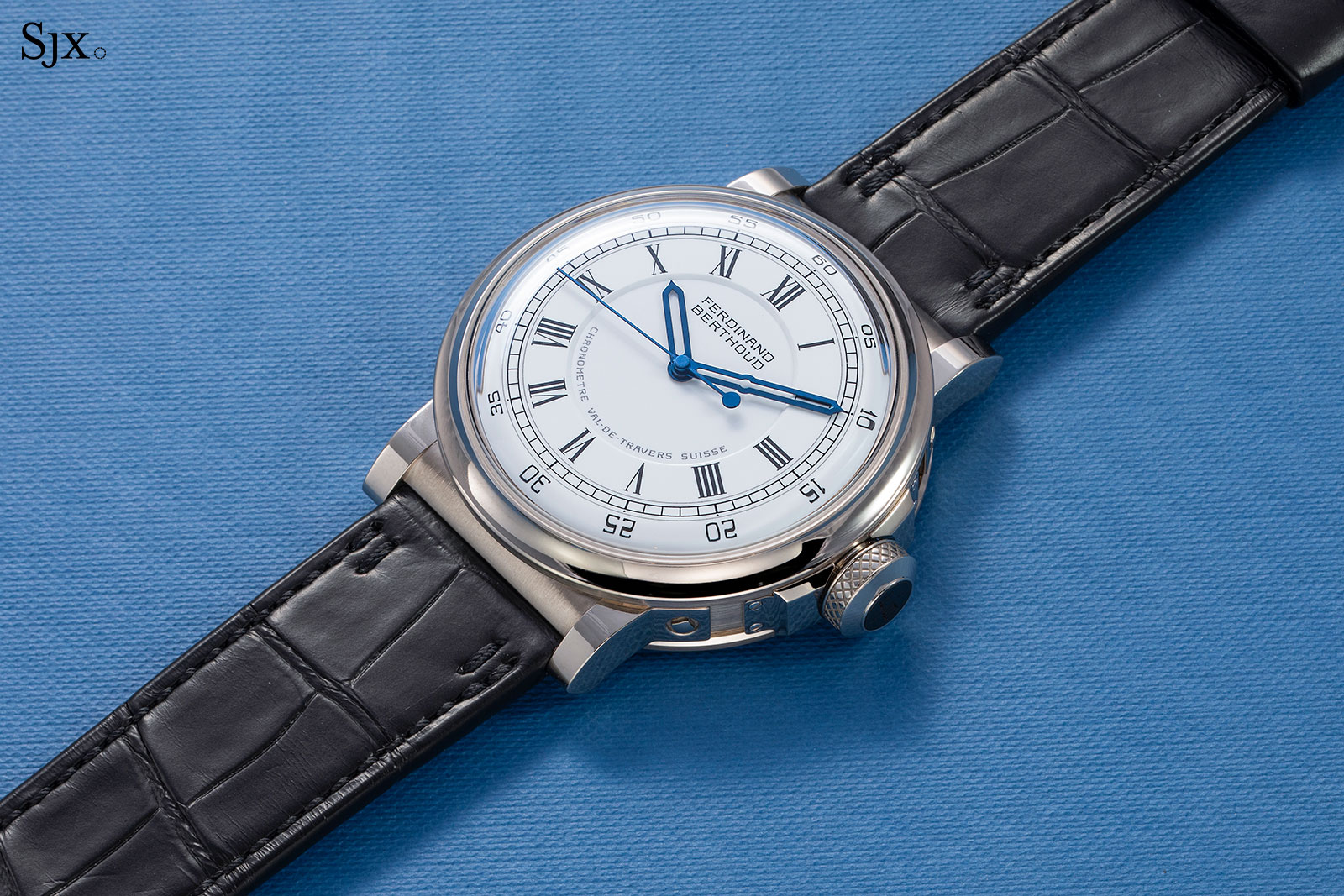
My first thought when I saw the watch: it is certainly a project driven by passion, rather than sensible commercial instinct, one reason, perhaps, it is so good. Not only is it extremely well made and esoteric in its mechanical features, the FB 2RE will be made in tiny numbers, and is also very expensive. The FB 2RE doesn’t really make sense, but it is a wonderful timepiece.
That perhaps is unsurprisingly, given that the revival of Ferdinand Berthoud, an 18th century French watchmaker, is the pet project of Karl-Friedrich Scheufele, co-president of Chopard. I have only spoken with Mr Scheufele briefly on several occasions, but industry insiders are unanimous in their opinion that he is a true gentleman who has a deep love for fine watchmaking, and it shows in the FB 2RE.
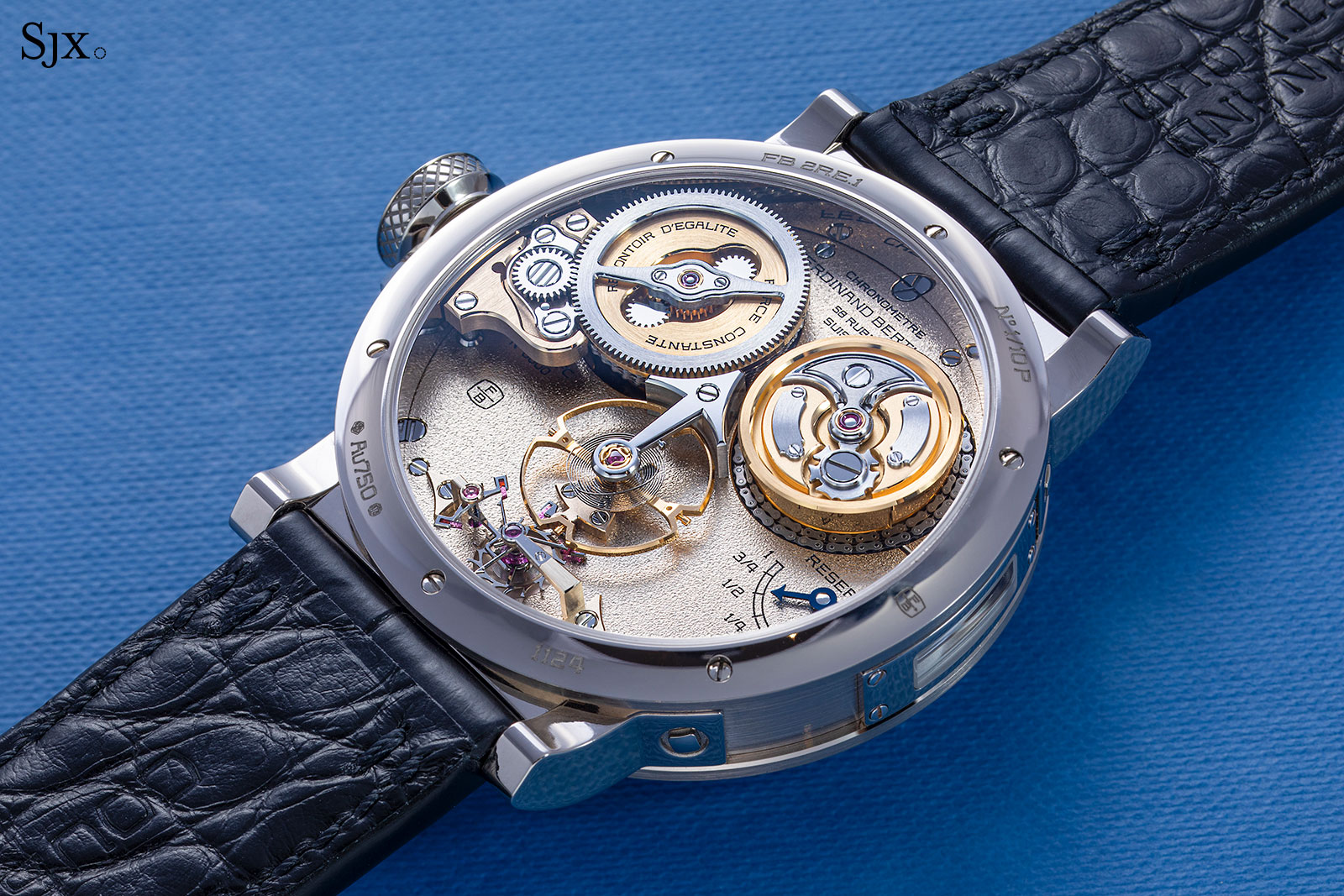
Like it predecessor, the FB 2RE is a large, chunky watch, but forgivably so because it feels like a high-quality instrument. The dial is classical, but appealing, while the case has an angular, mechanical look – both work surprisingly well. The look is attractive, albeit not outstanding.
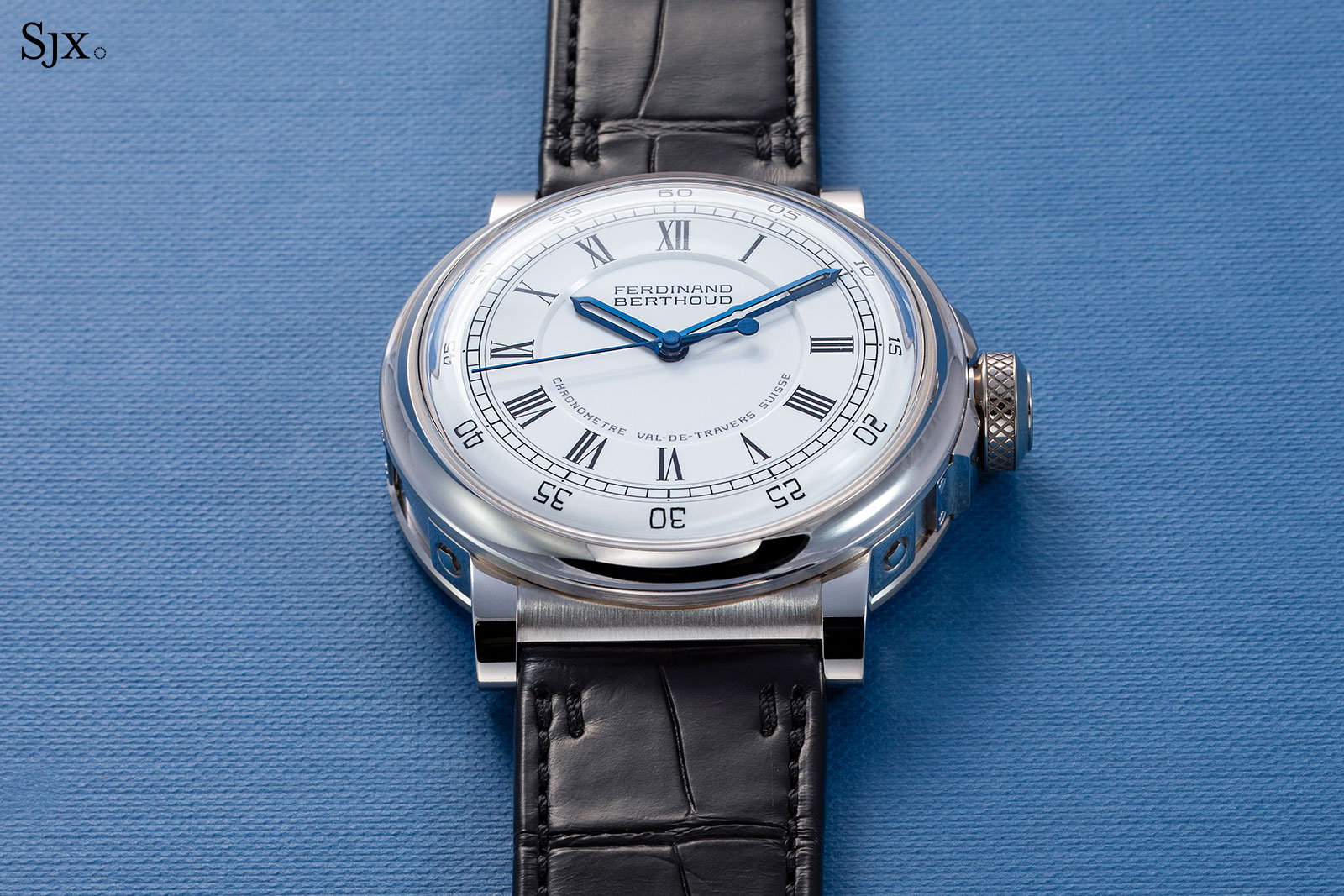
Turn it over and the movement is clearly outstanding. The movement has a gorgeous, architectural construction, with all of the key elements sitting above the base plate. And the decoration is impeccable, right down to the smallest components of the escapement.
There is some visual similarity to the long-delayed Derek Pratt wristwatch, but it is because both share the same historical inspiration (and I would personally pick the Berthoud over the Pratt; more on that below).
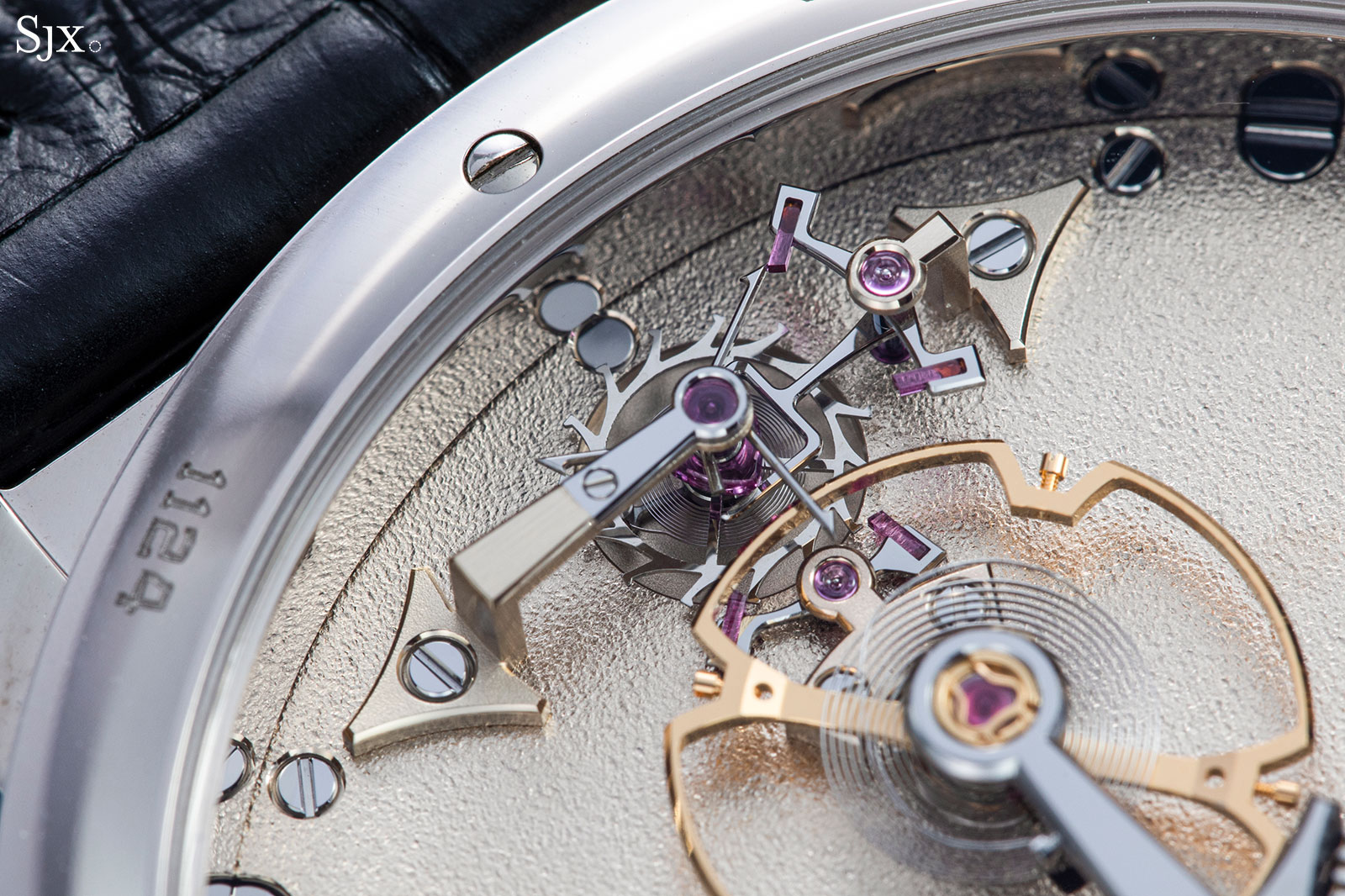
Importantly, all of that finery and engineering translates into actual chronometric performance. When subject to the Fleuritest over 54 hours – a timing examination performance by an automated machine that simulates wear on the wrist at varying temperatures and positions – the FB 2RE delivers exemplary results, with an average deviation of under 0.5 seconds a day.
The only weakness of the watch is the price. At about 210,000 Swiss francs, which is about US$230,000, it is not exorbitantly priced, but it is expensive.
Marine clock inspiration
The FB 2RE is inspired by the Ferdinand Berthoud marine clock no. 6, a precision timepiece that underwent sea trials (along with clock no. 8) in 1768. Both clocks passed the test, leading to Berthoud’s appointment in 1770 as clockmaker to the French crown and navy.
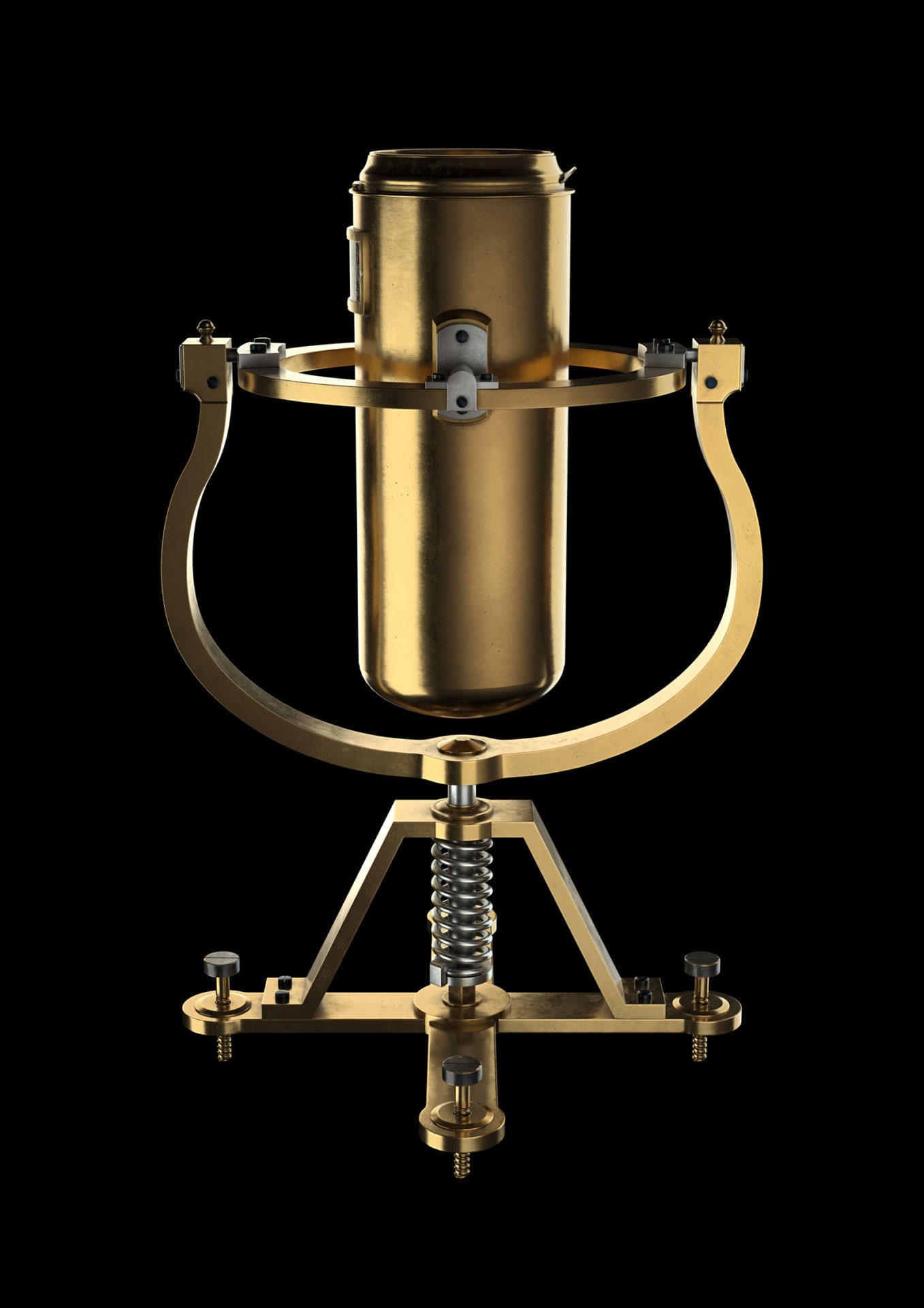
The marine clock no. 6. Image – Ferdinand Berthoud
A precision clock held in a gimbal on a spring-damped brass post meant to be screwed to the deck, the marine clock no. 6 is an early example of a marine chronometer. Its robust construction has been translated into the case design of the FB 2RE, which is a multi-part affair held together by large screws and bolts.
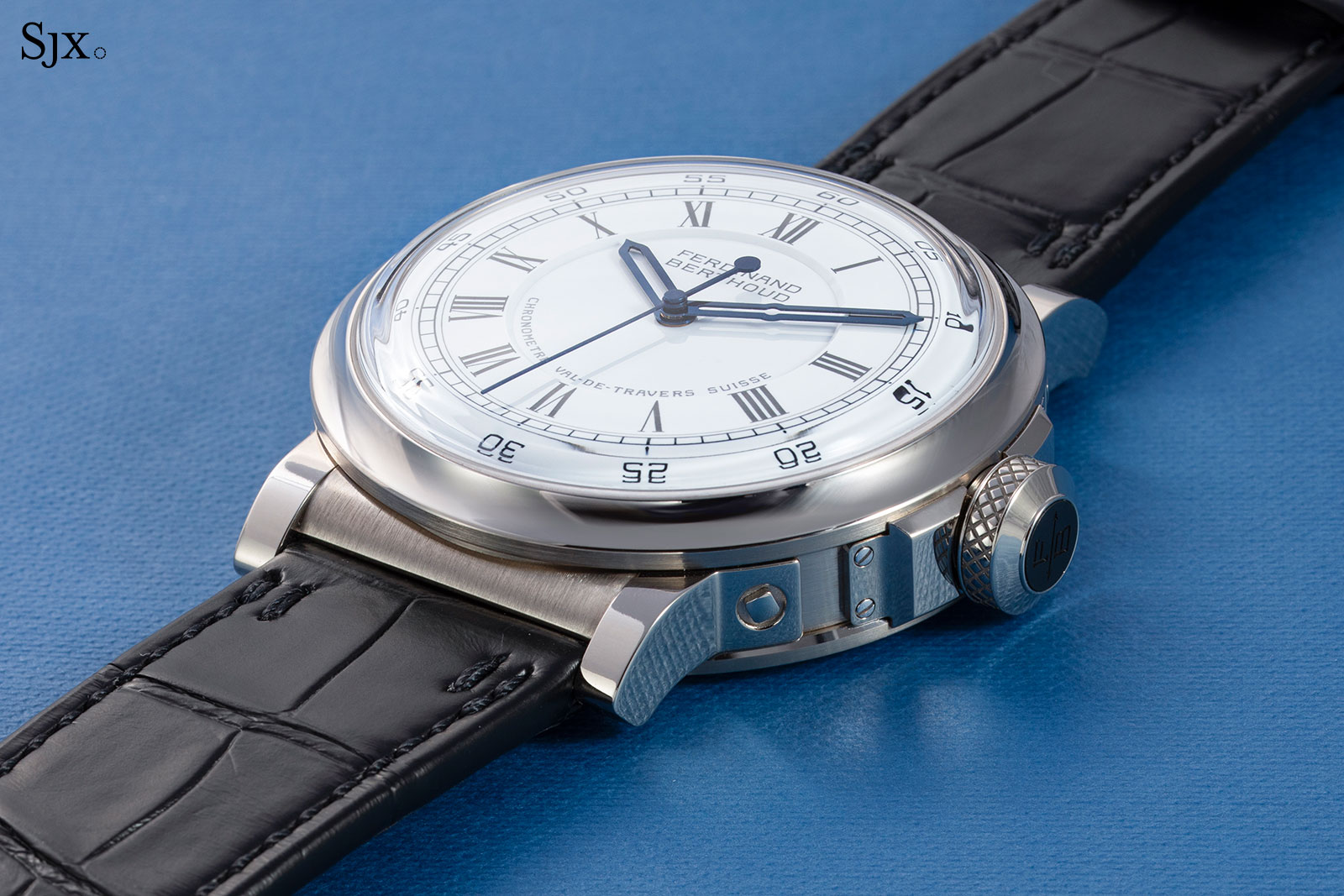
The stout lugs are attached to the case band with bolts, while the crown guard and porthole are held in place by screws. The result is an instrument-like aesthetic that suits the inspiration of the watch.
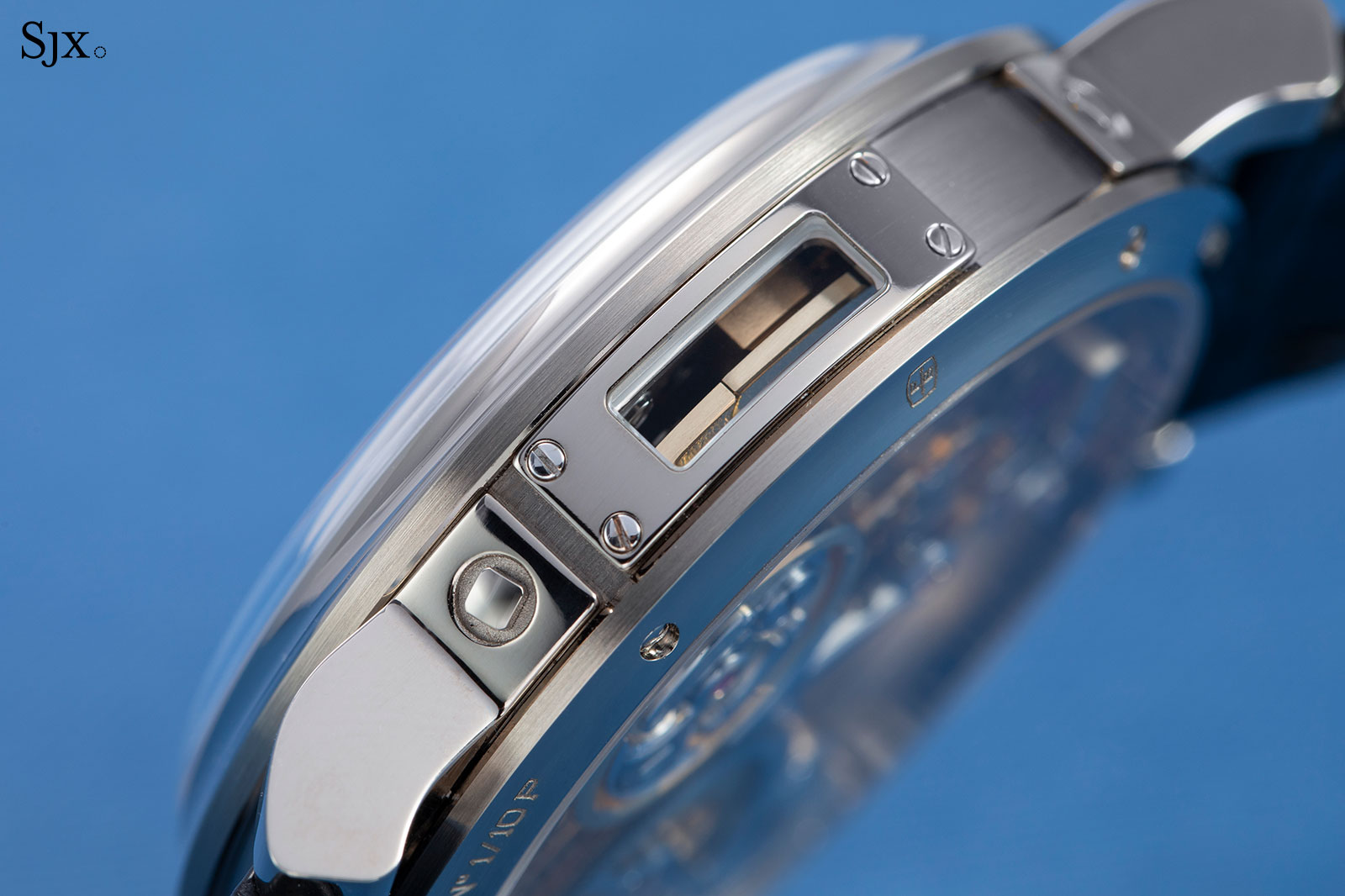
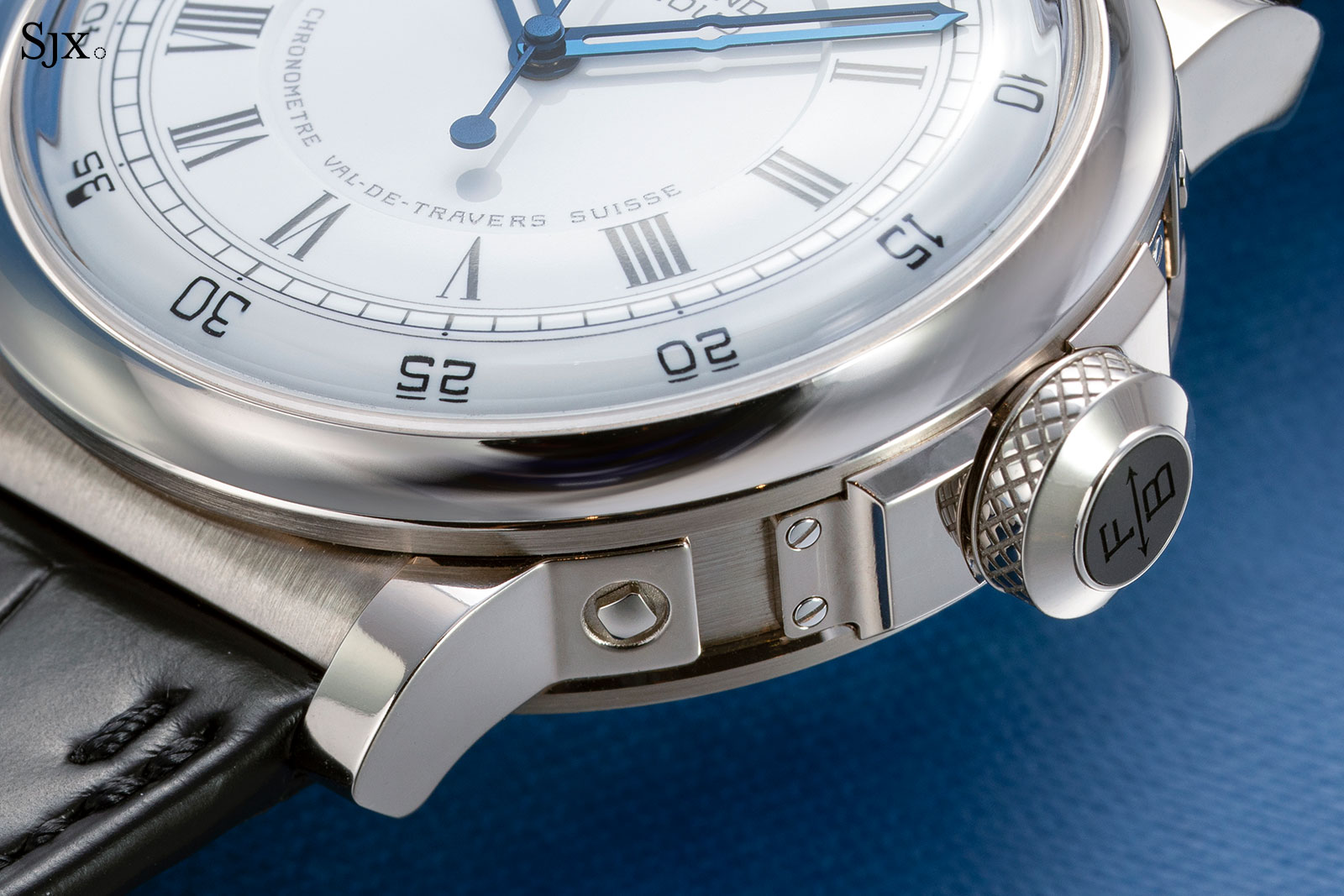
At 44 mm by 14 mm, the case is big, and feels big on the wrist. It’s a good kind of big – the case components are refined, while the movement is large, so the entire watch feels proper. No doubt some will wish for a smaller case, but a meaningful reduction in case size is not possible due to the size of the movement.
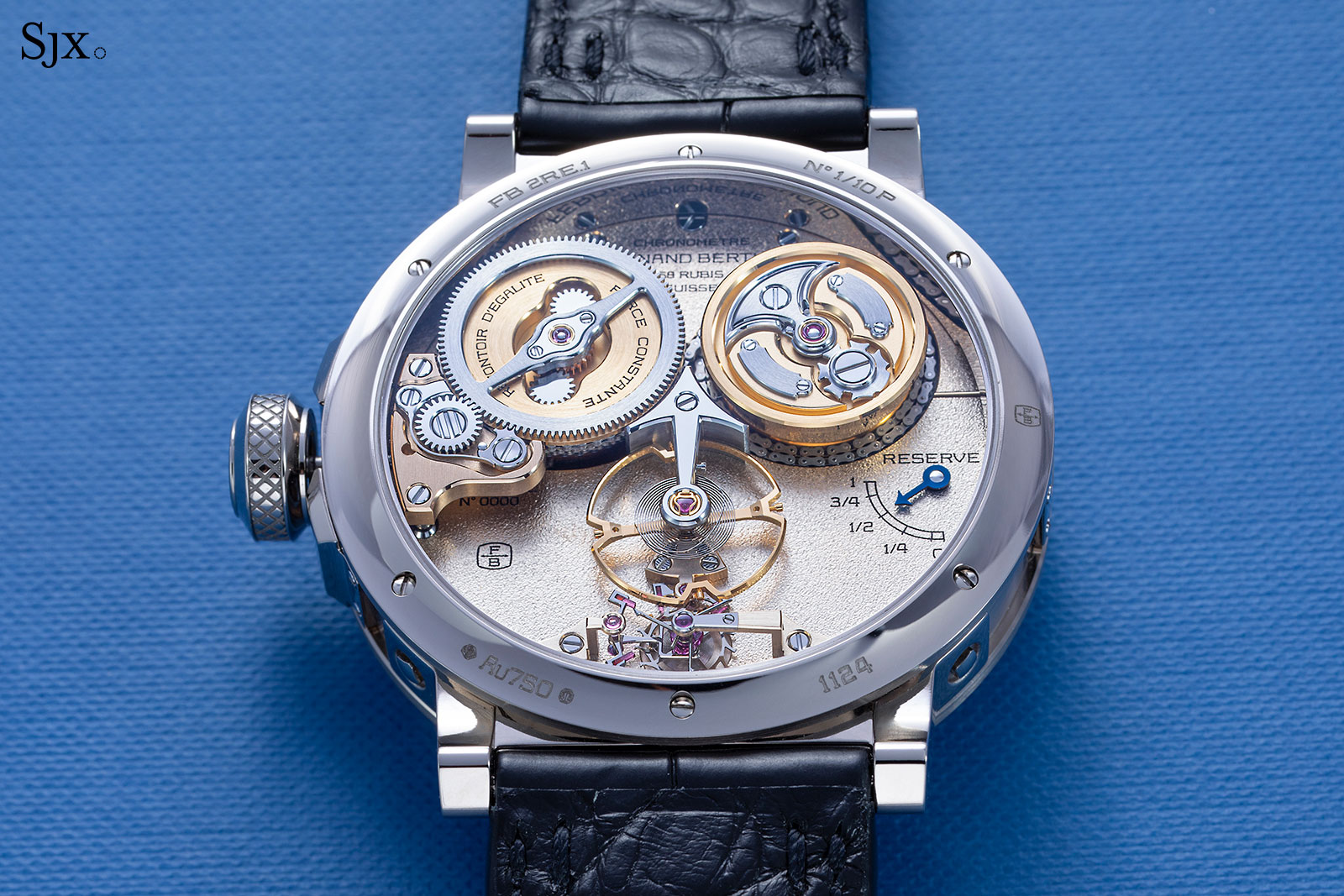
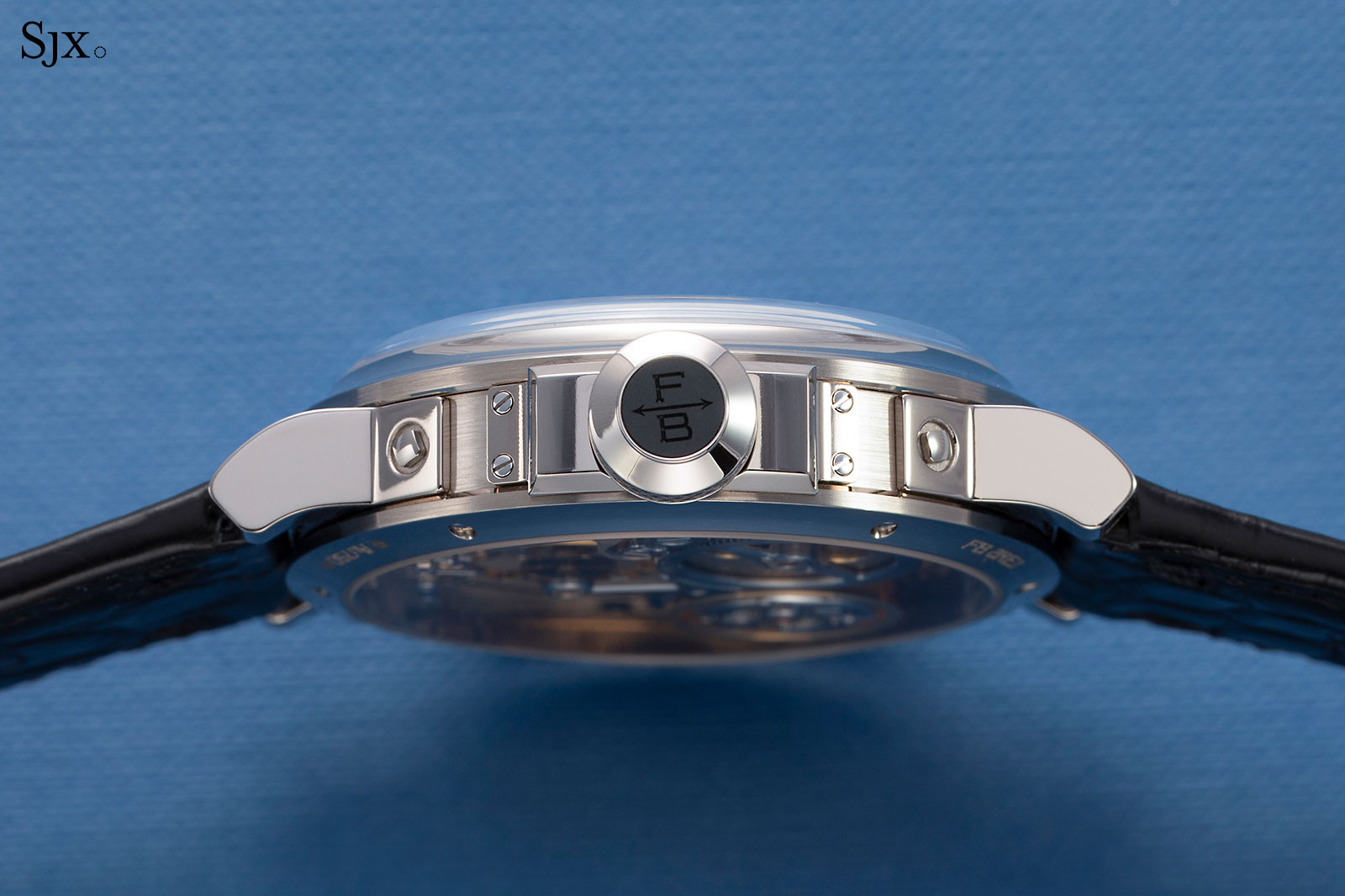
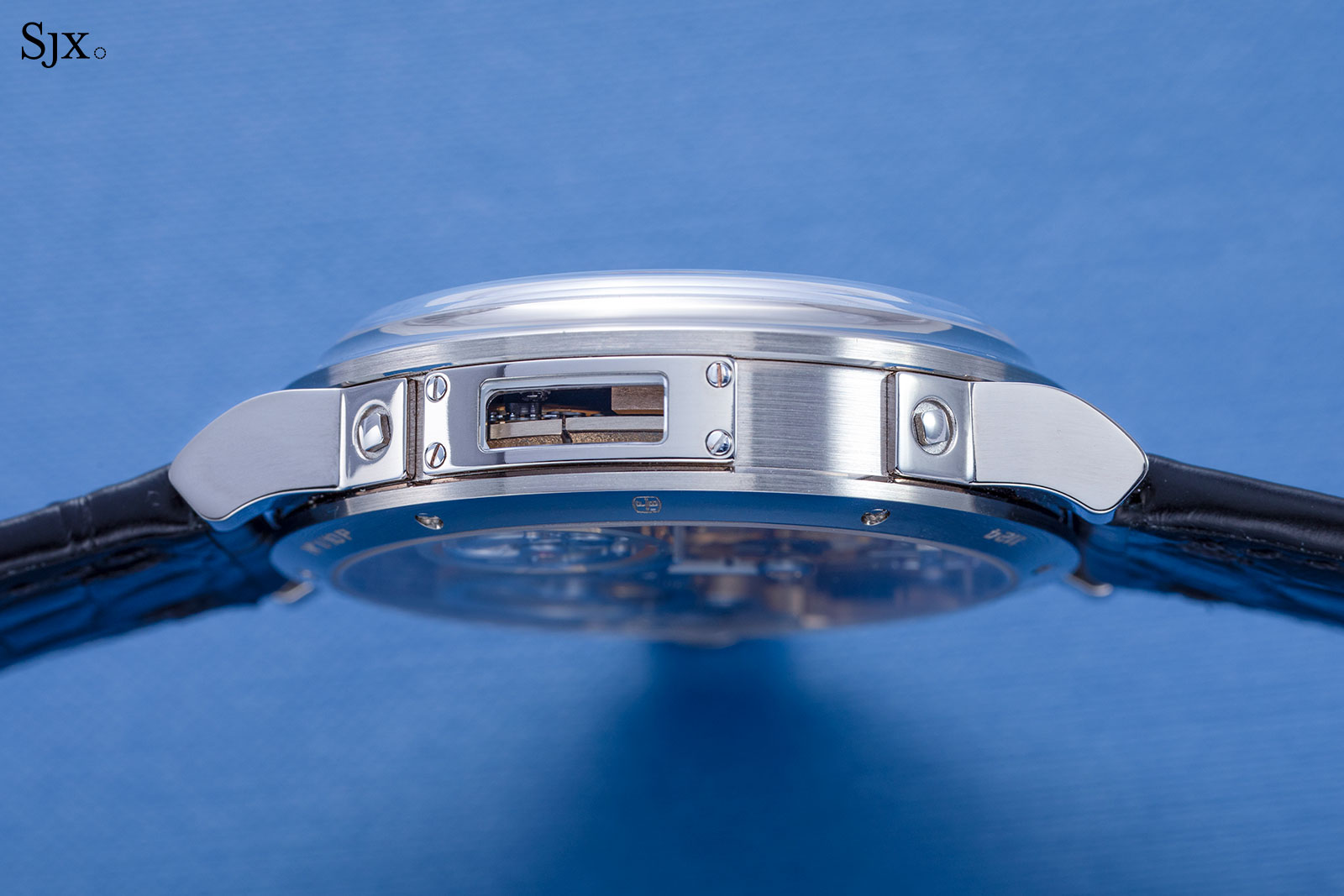
One notable detail is the extra-large crown that continues the instrument-like look. Winding the watch is a pleasure – the sensation is both smooth and tactile – and the winding mechanism disengages once the mainspring is fully wound.
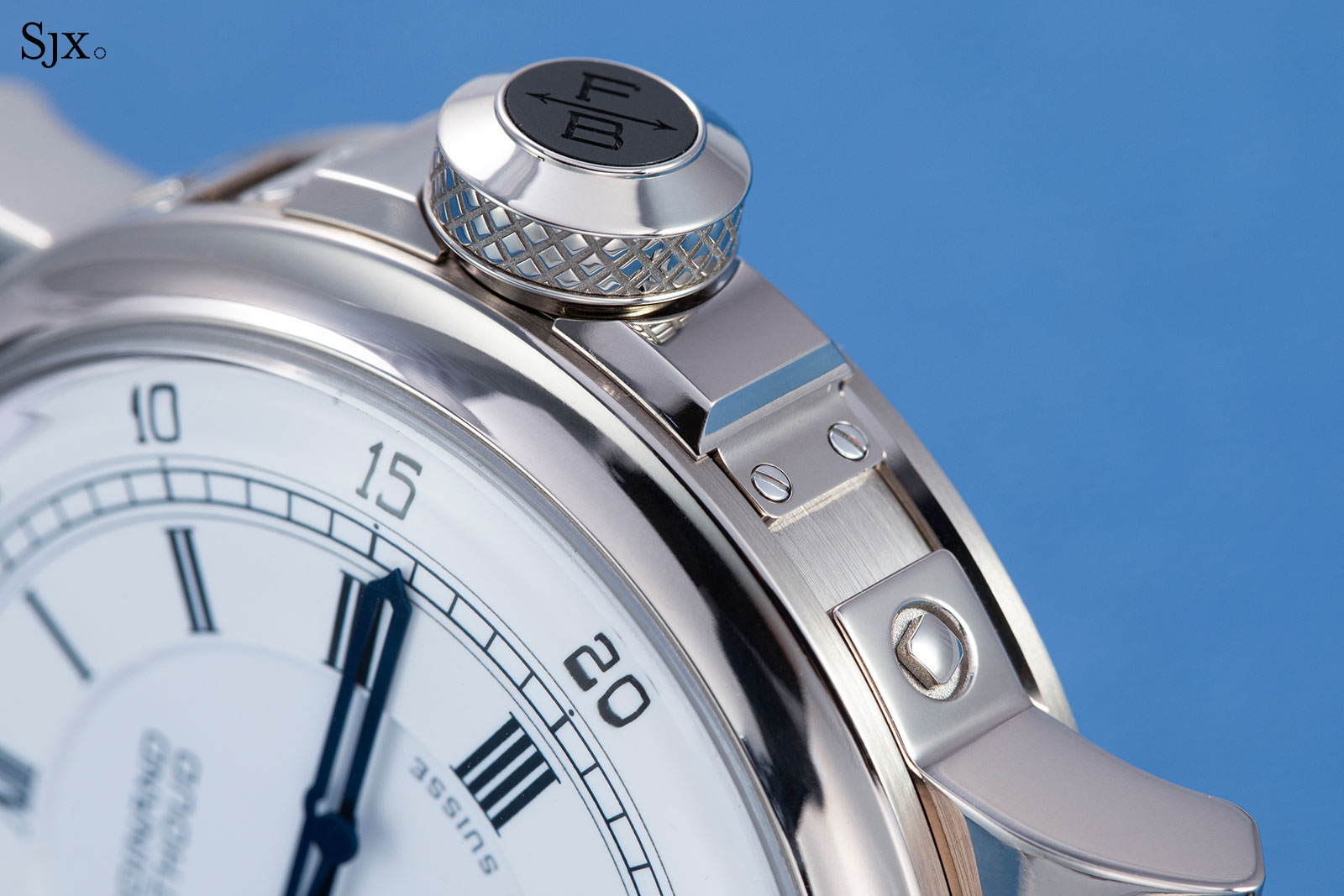
Far simple and more classical than the case, the dial would not be out of place on a marine chronometer or pocket watch. But like the case, it is elaborately and expensively executed. And the dial is also extremely legible thanks to its sensible design.
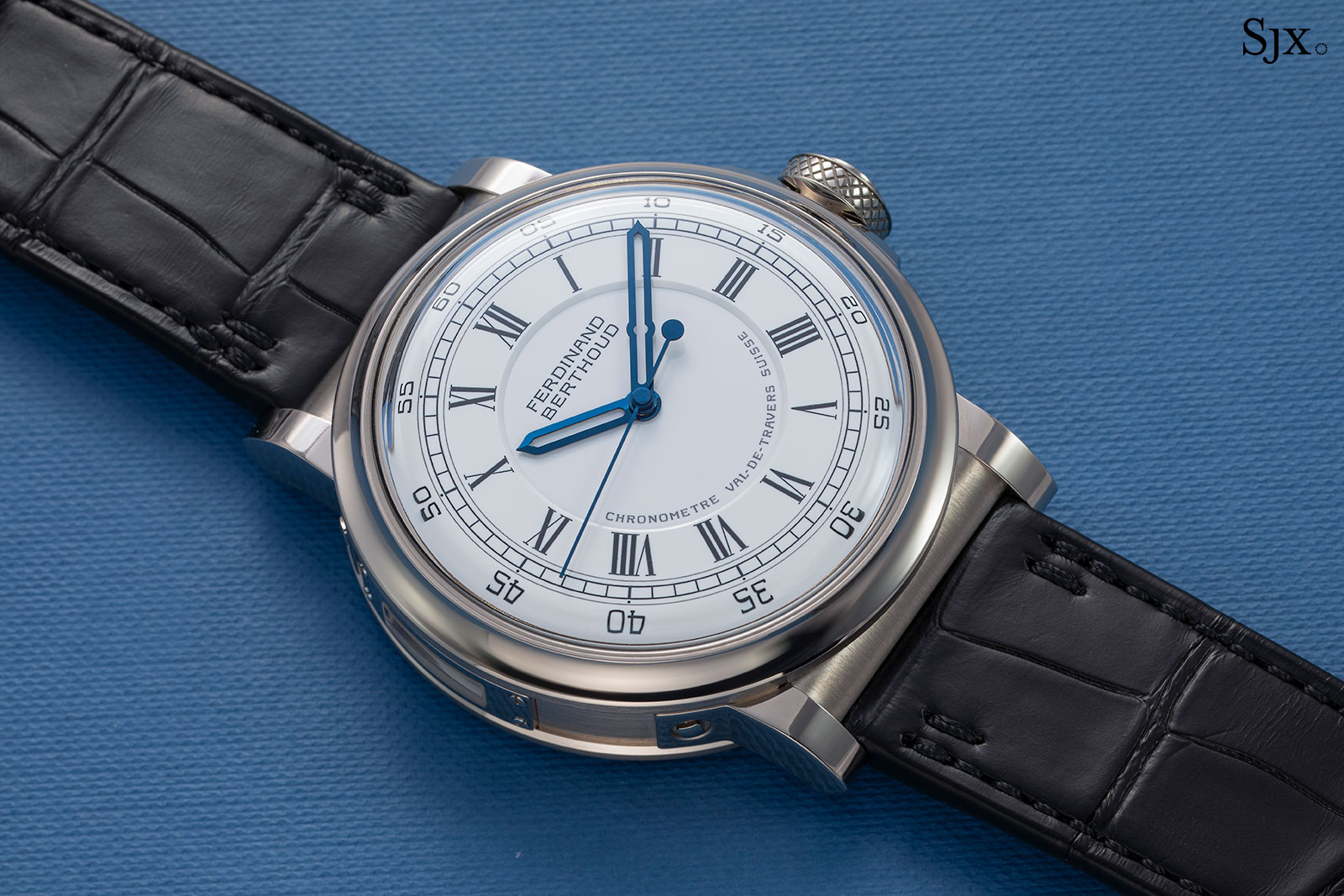
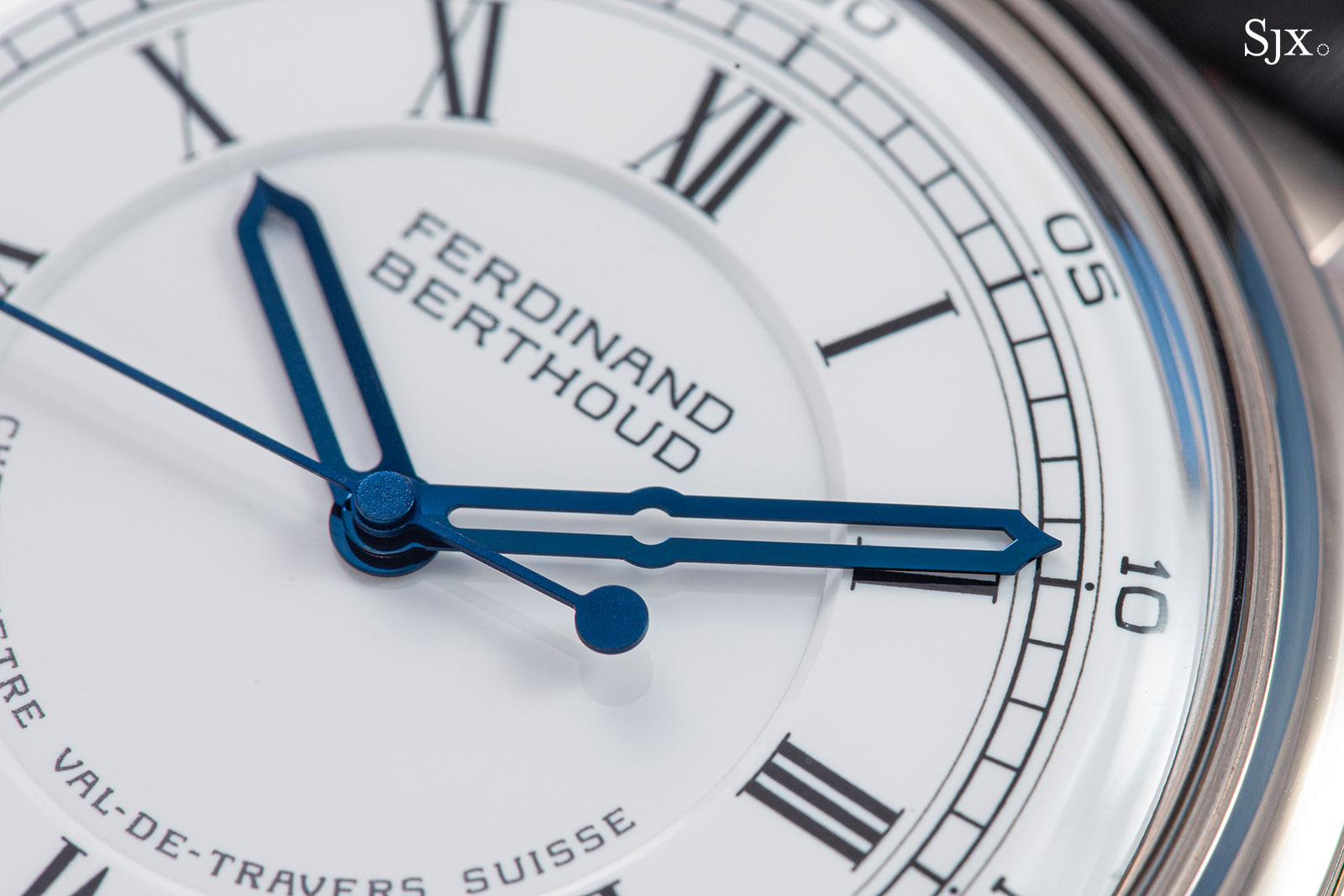
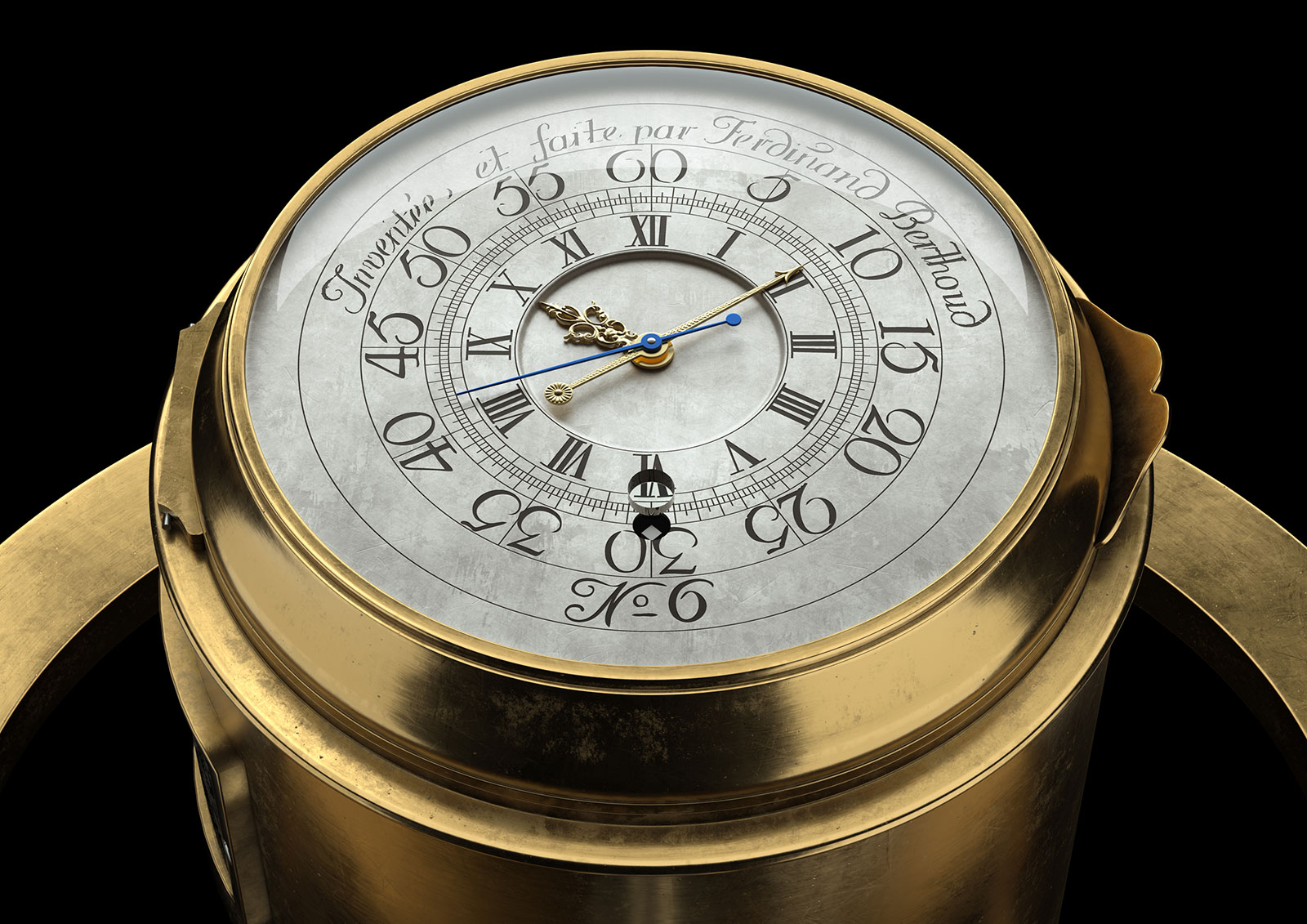
The face of the marine clock no. 6 that inspired the dial. Image – Ferdinand Berthoud
In white or black enamel depending on the case material, the dial is a two-parter – a gently domed outer track for the hours and minutes, and a flat central portion – but entirely in fired, vitreous enamel. All of the markings on the dial are also enamel; first printed in enamel and then fired in an oven to set.
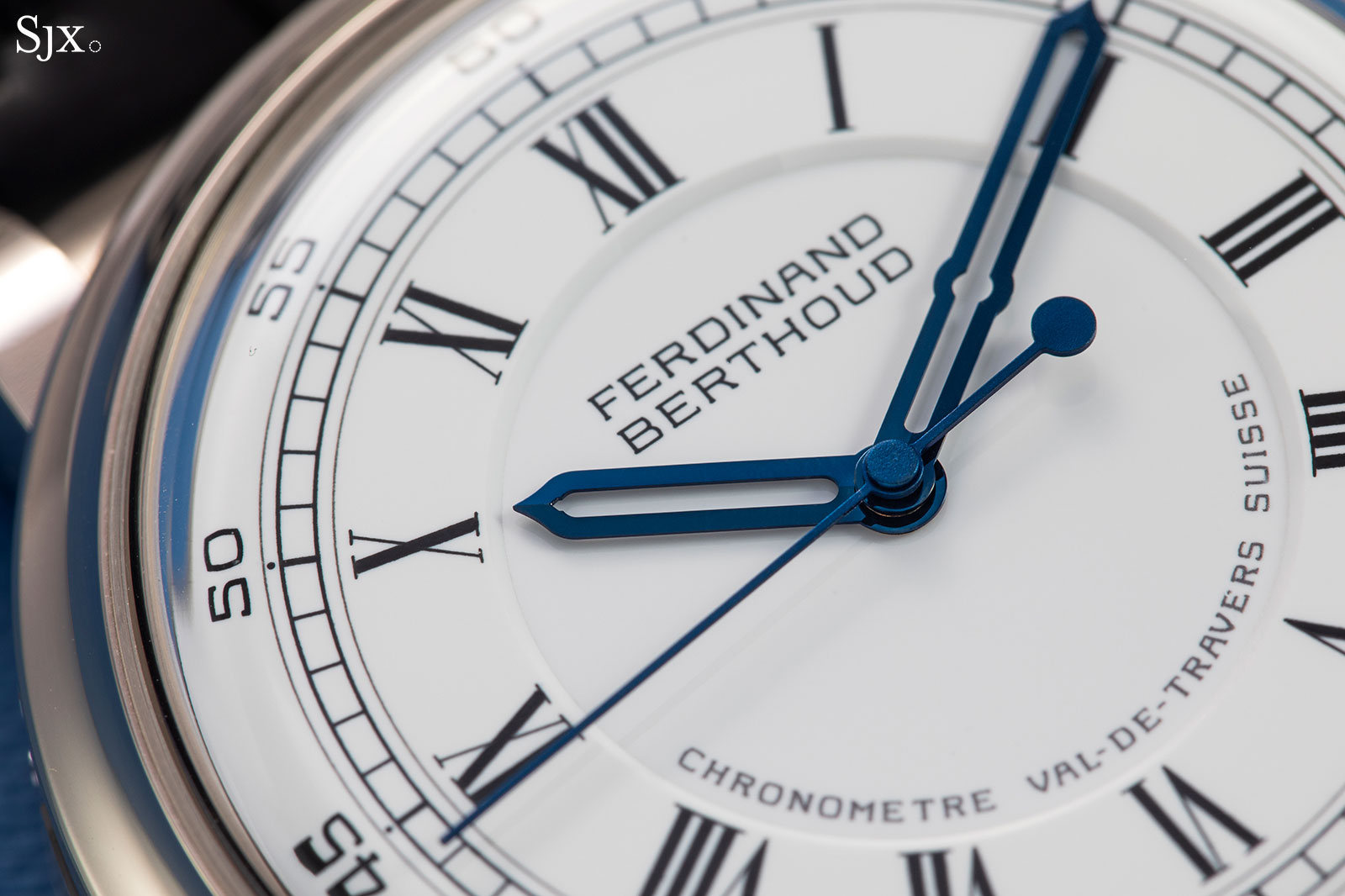
The recessed central portion also serves to accommodate the hour hand, which sits flush with the raised portion chapter ring
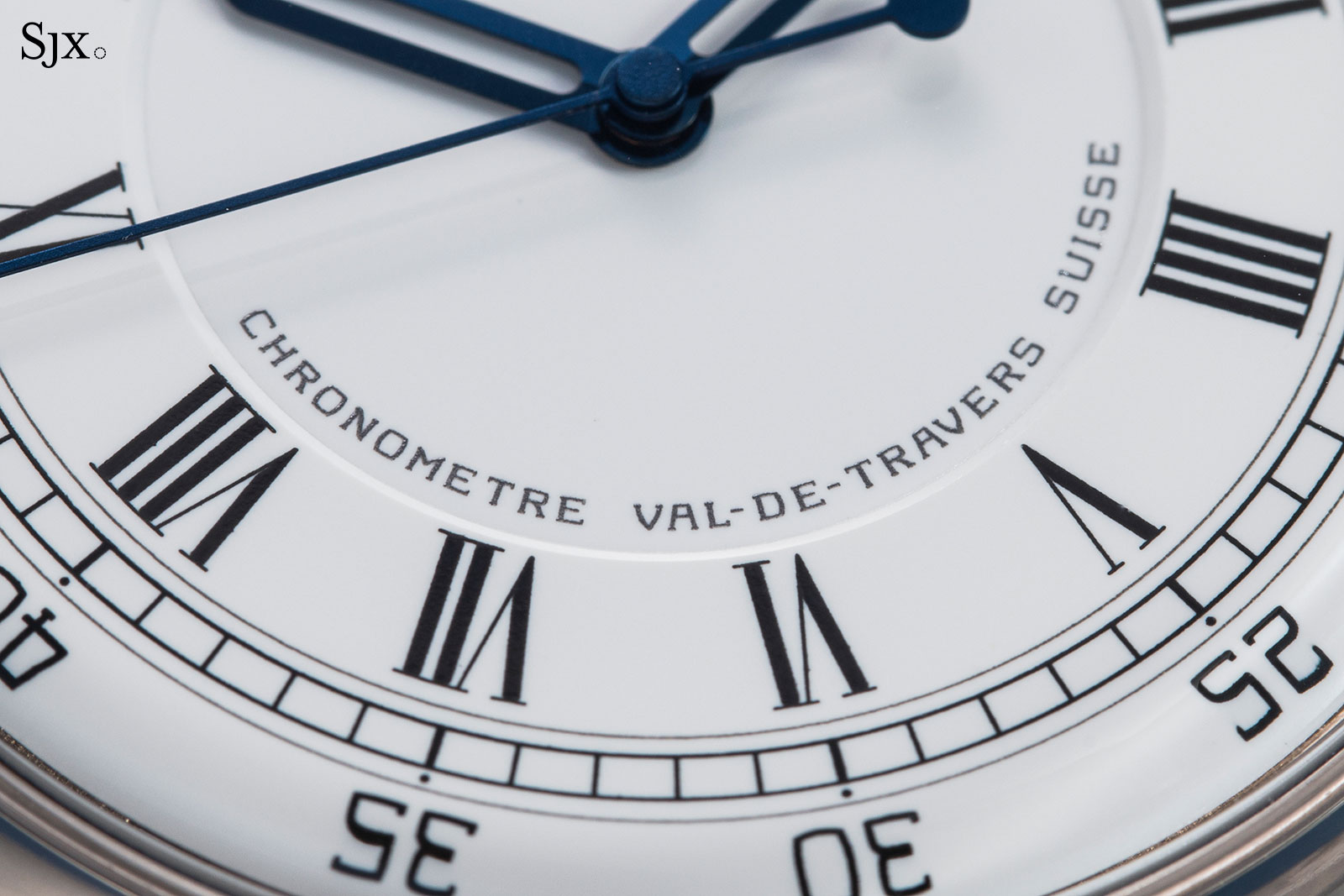
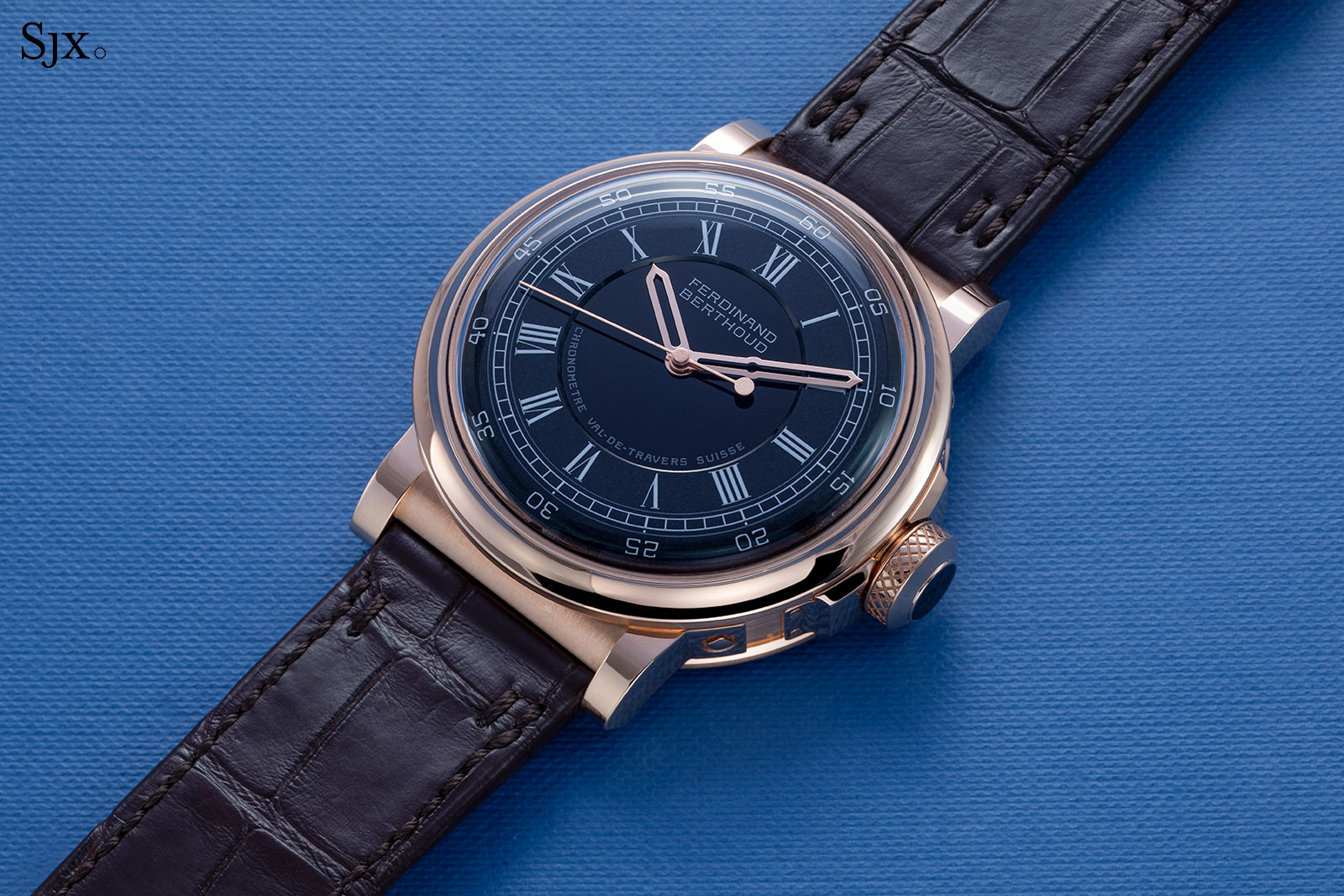
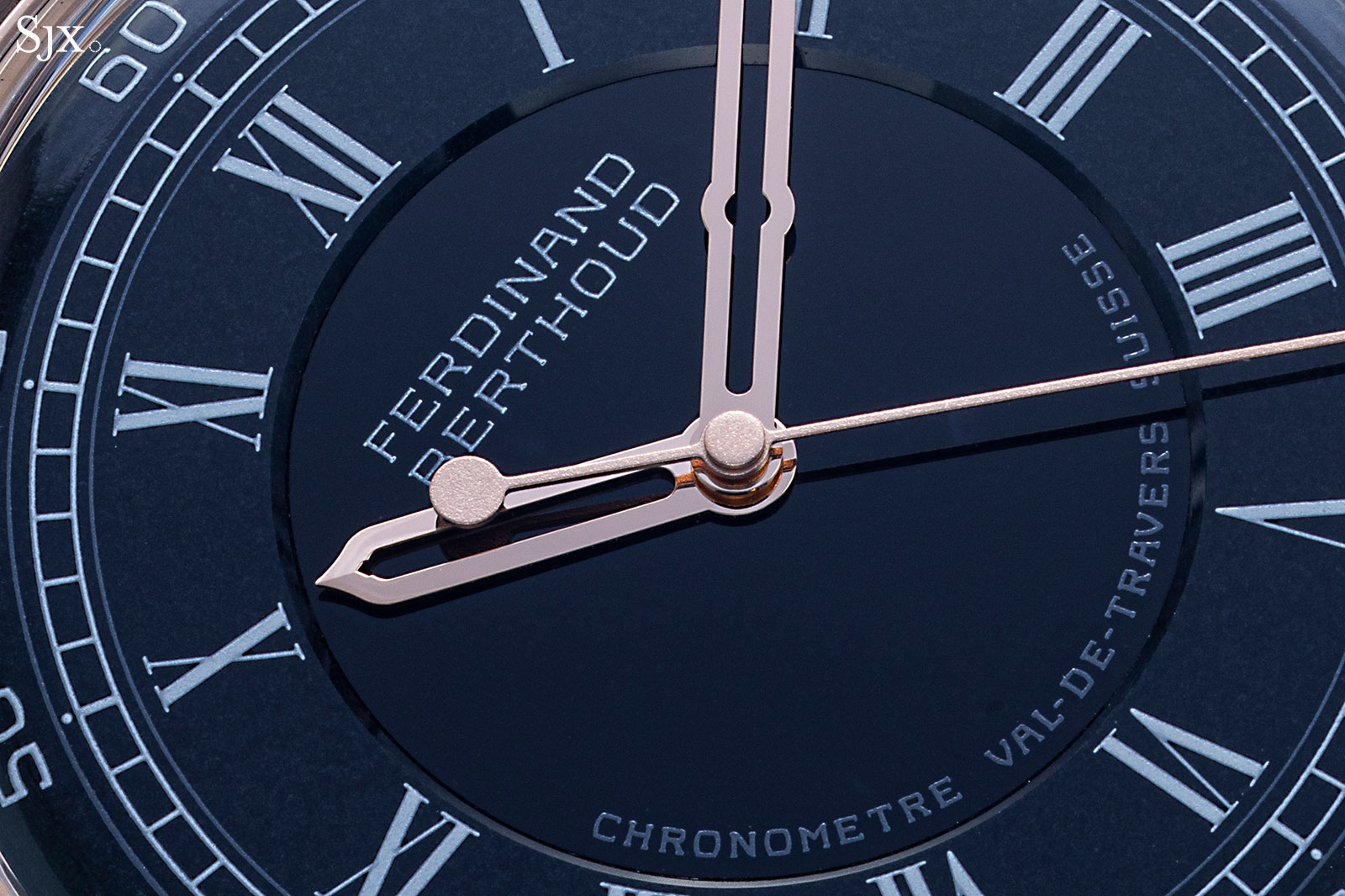
The black enamel dial in the rose-gold version
Interestingly, the dial base is steel, instead of the usual silver or gold. According to Ferdinand Berthoud, this allows for a thinner dial as the steel base does not require “counter enamel”, which is enamelling on the reverse of the dial to prevent warping.
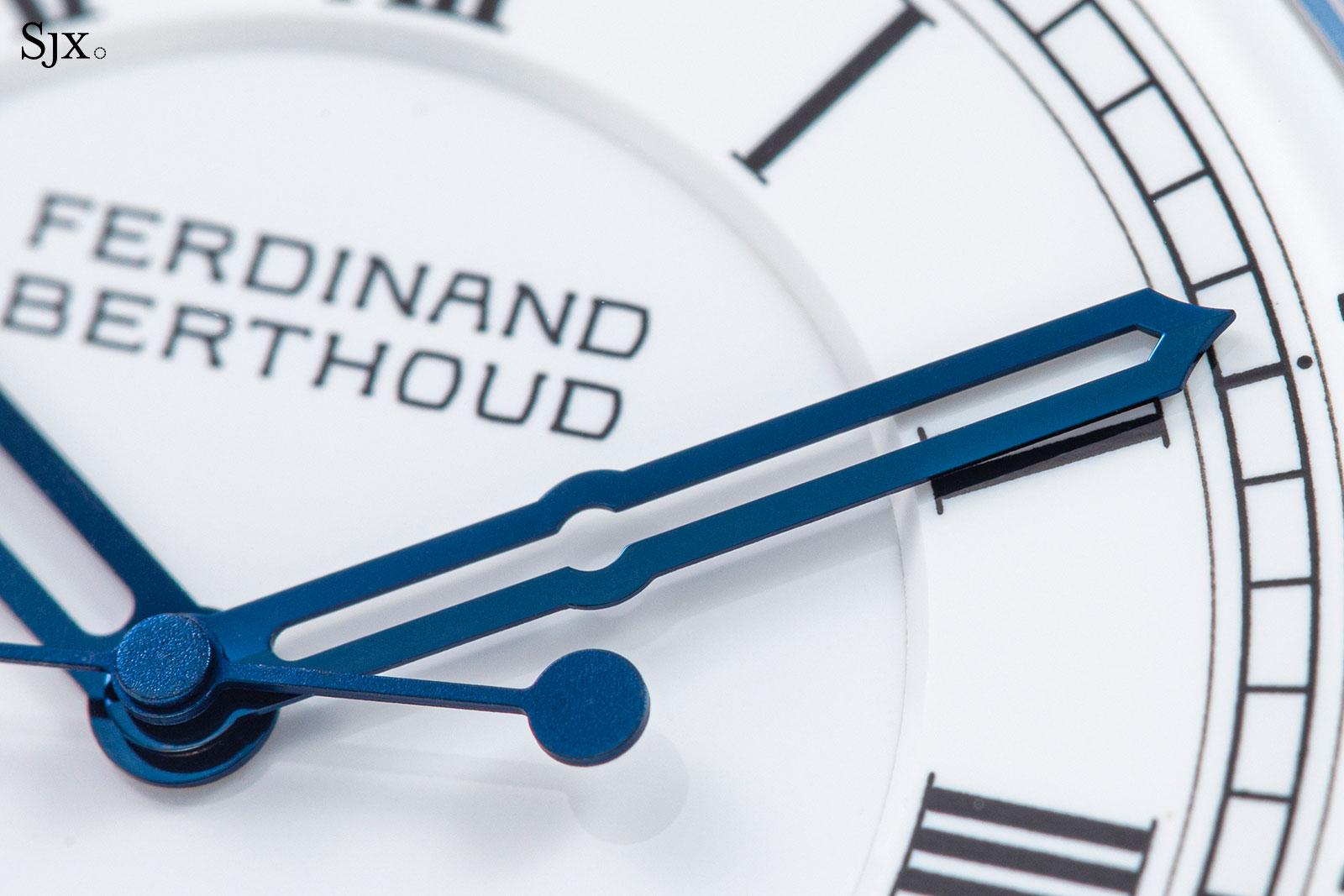
The hour and minute hands are blue-coated, polished gold, while the seconds hand is blue-coated, frosted titanium for lightness. Because the titanium second hand is so slim and flat, it cannot be mirror polished like the hour and minute hands.
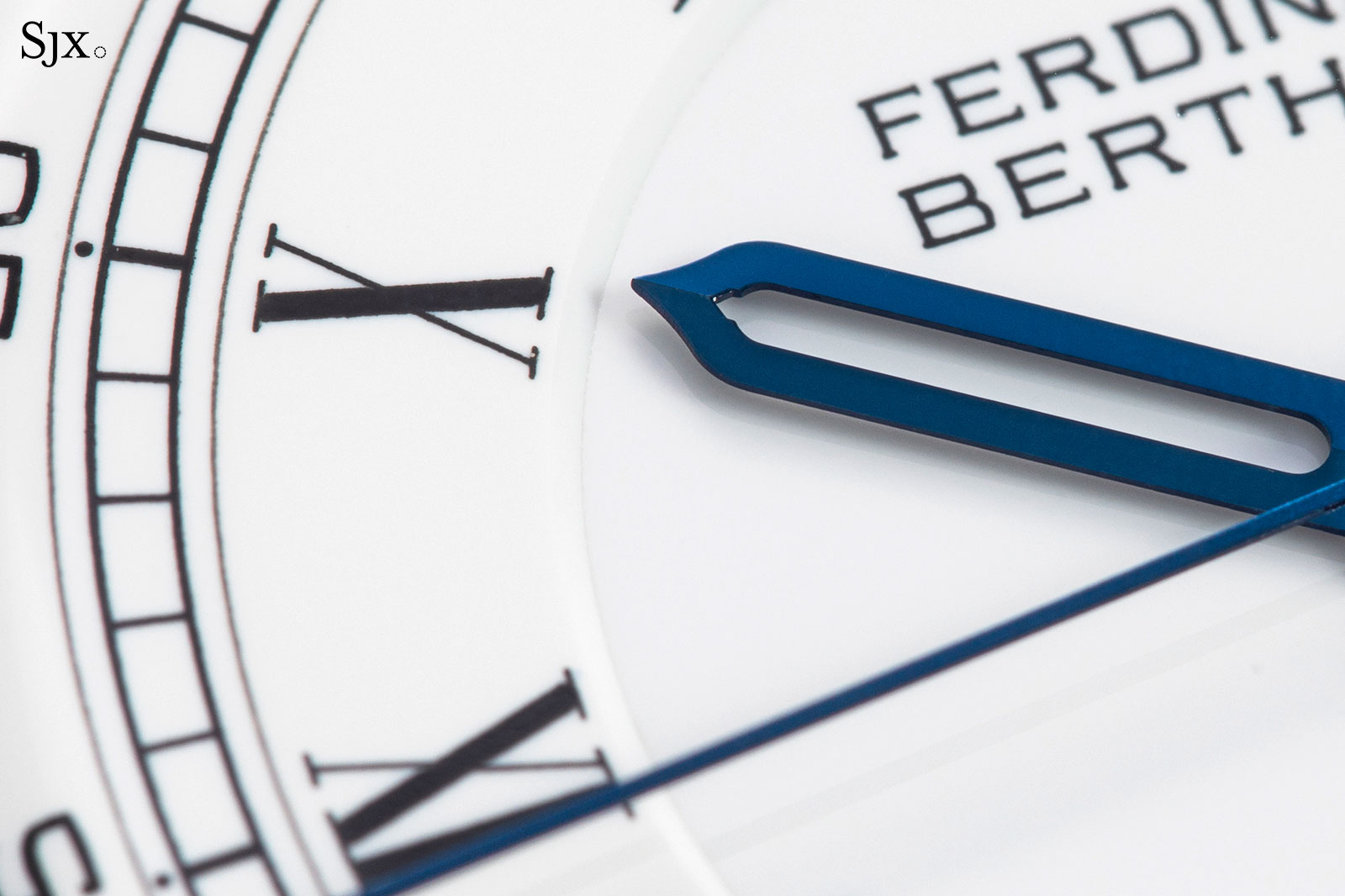
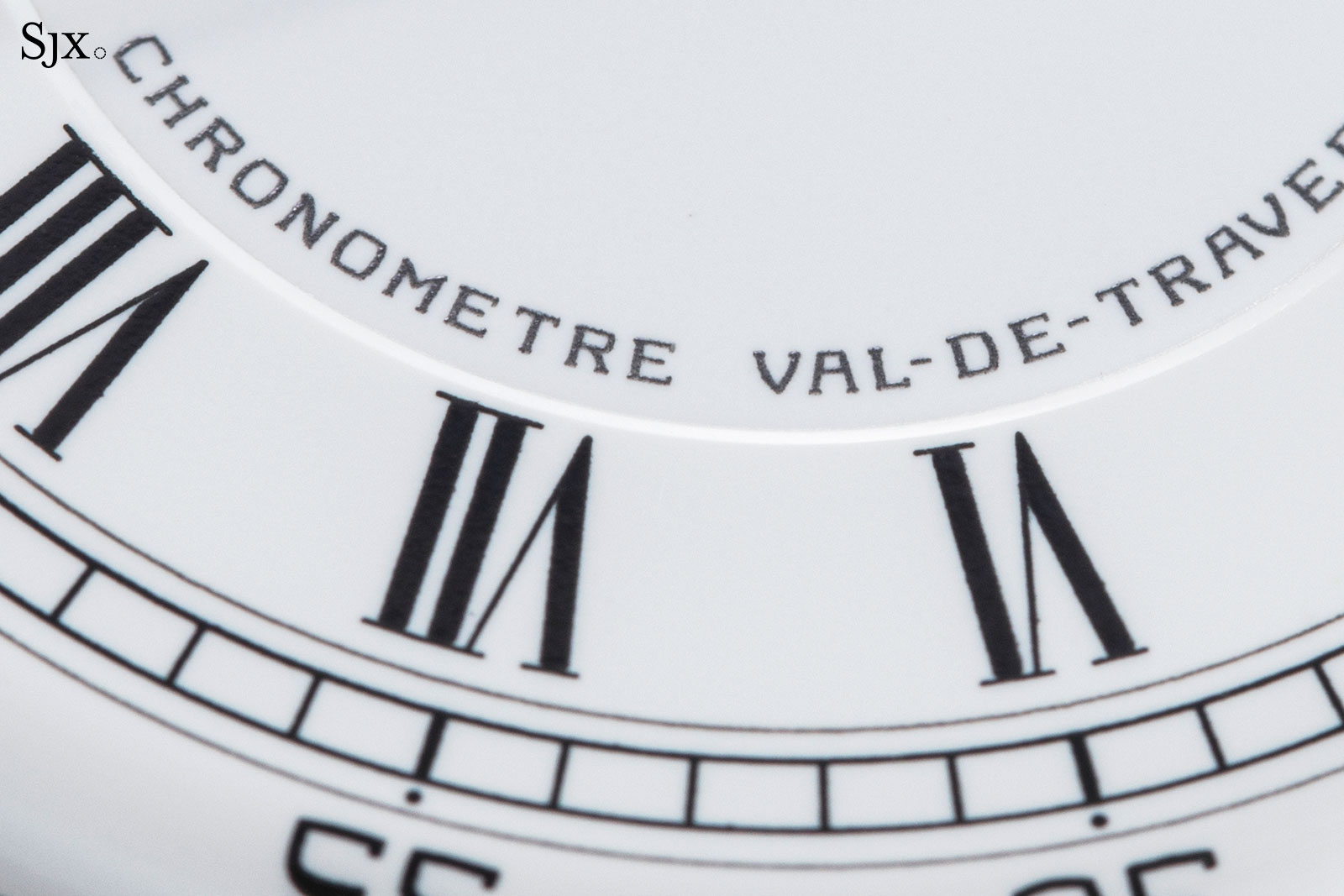
Calibre FB-RE.FC
Developed by Ferdinand Berthoud (with a help from an external specialist during the early stages of conception), the FB-RE.FC movement is symmetrical, three-dimensional, and beautiful. And because all of the key components sit high above the base plate, the depth of the movement is impressive, and enhanced by the mirror-polished walls of the case interior.
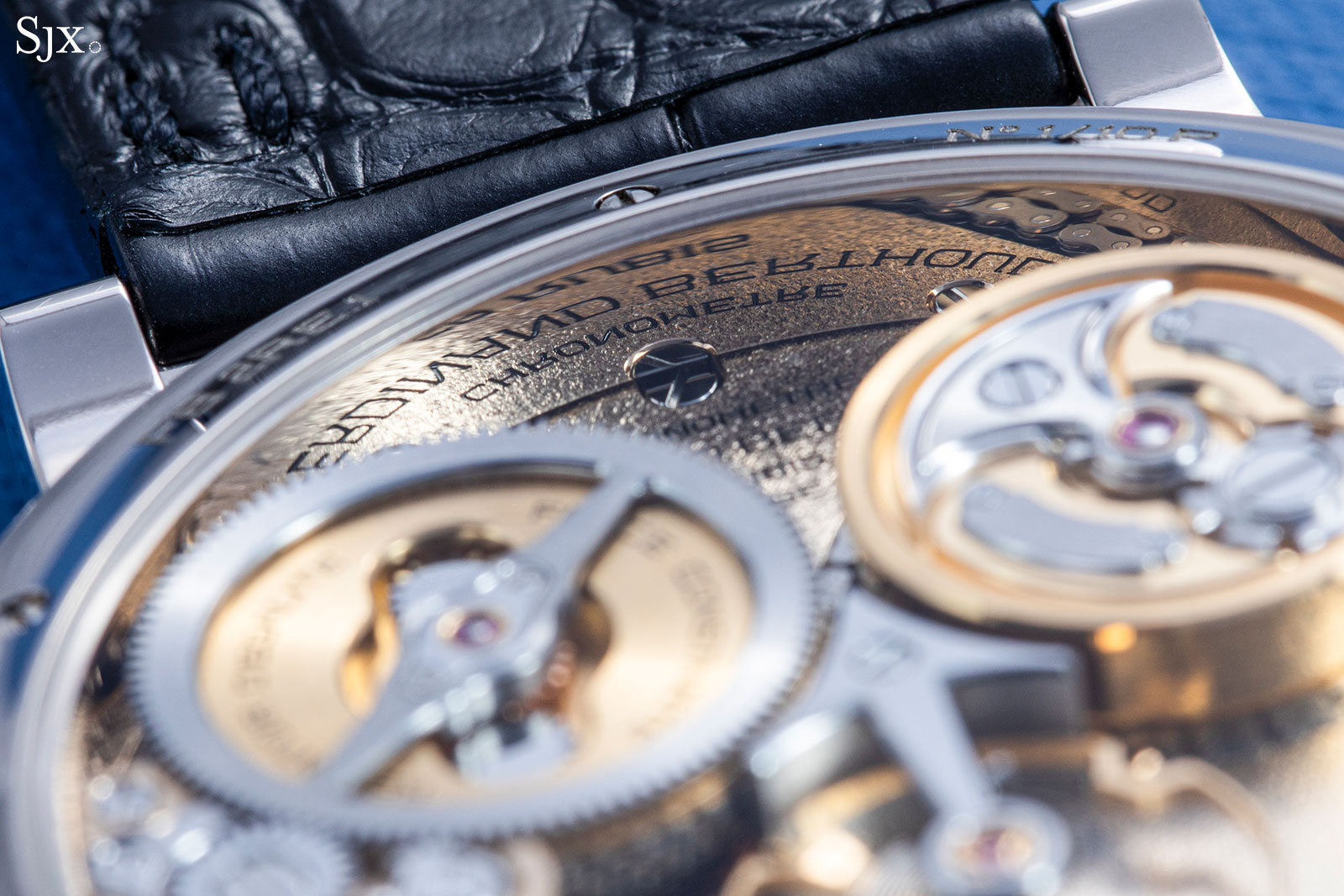
The FB-RE.FC is an ideal timekeeper, at least in terms of old-school watchmaking technology. It boasts both a constant power delivery thanks to the chain and fusee, as well as a constant power release as a result of the remontoir d’egalite.
The construction is also old fashioned, with the gear train and other moving parts sandwiched in-between two large plates separated by pillars, much like in an actual marine chronometer.
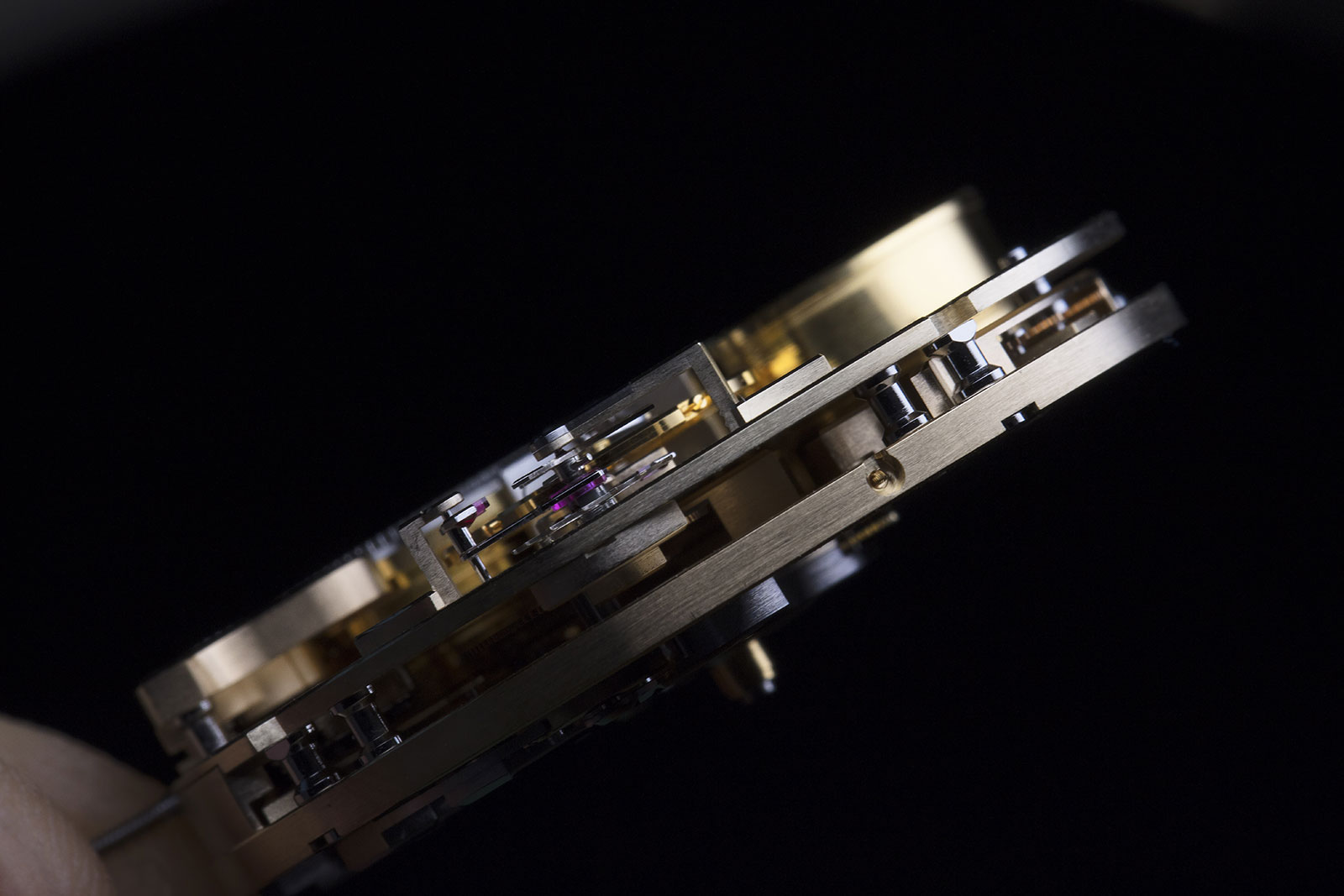
The movement seen from its side, revealing the twin plates and pillars. Image – Ferdinand Berthoud
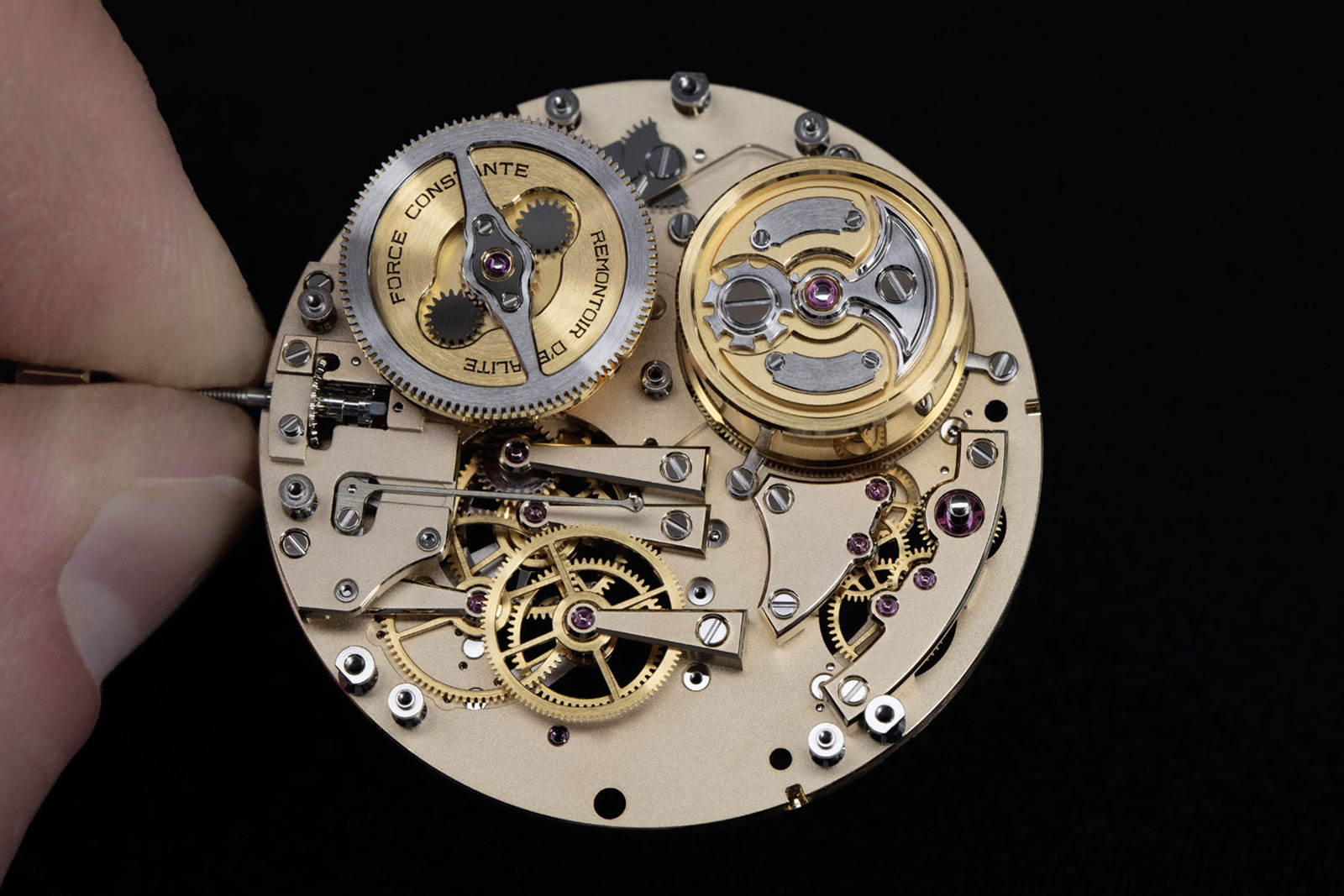
The movement with the upper plate removed, revealing the gear train and also the lever for the hacking seconds. Image – Ferdinand Berthoud
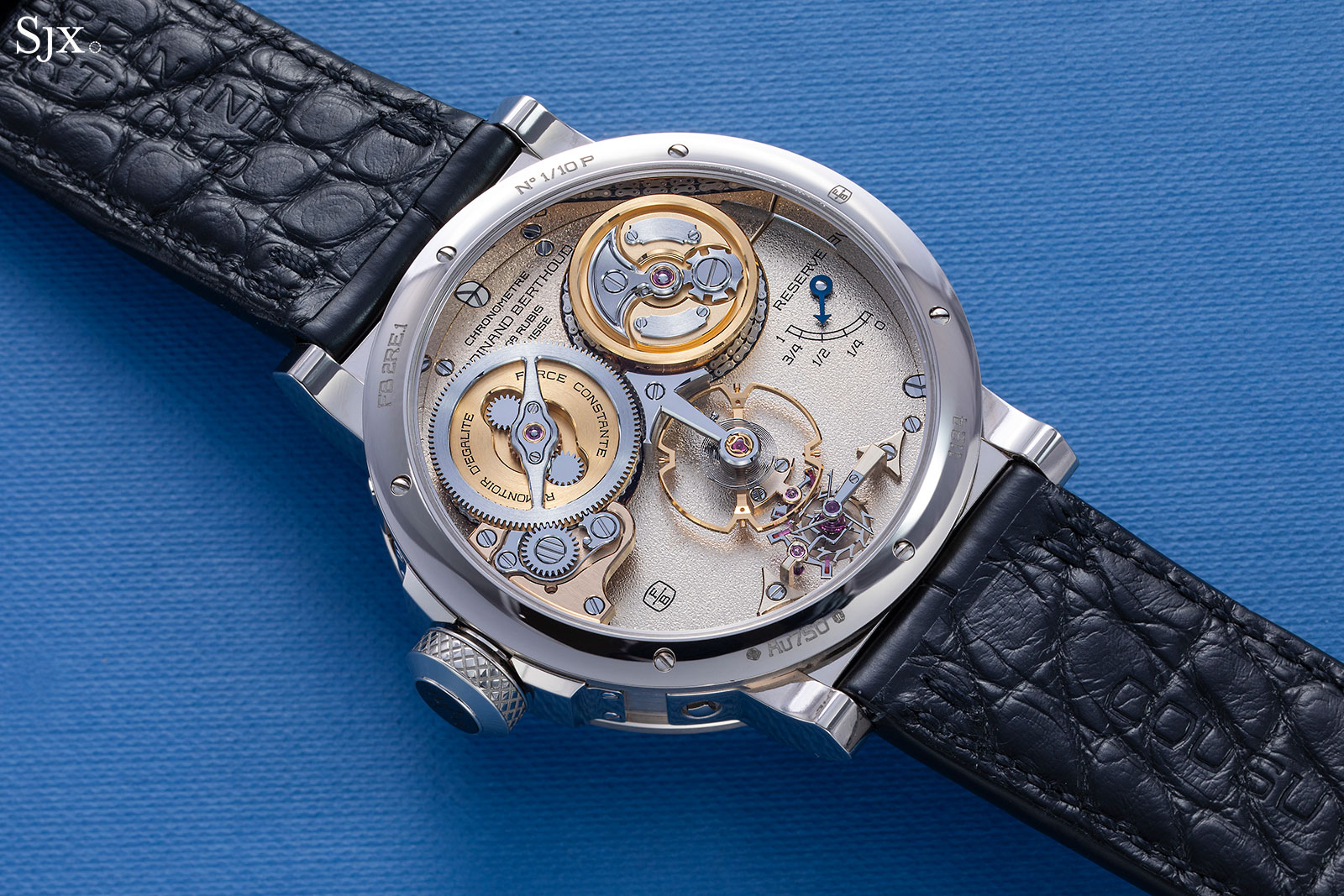
Mounted on the upper plate are the key mechanisms of the movement. The upper half is occupied by the chain and fusee mechanism, which is similar to that found in the FB1. Relying on the principal of leverage, a chain and cone (the fusée, or rocket) ensure the mainspring delivers constant energy to the escapement, even when it is fully wound or nearly empty.
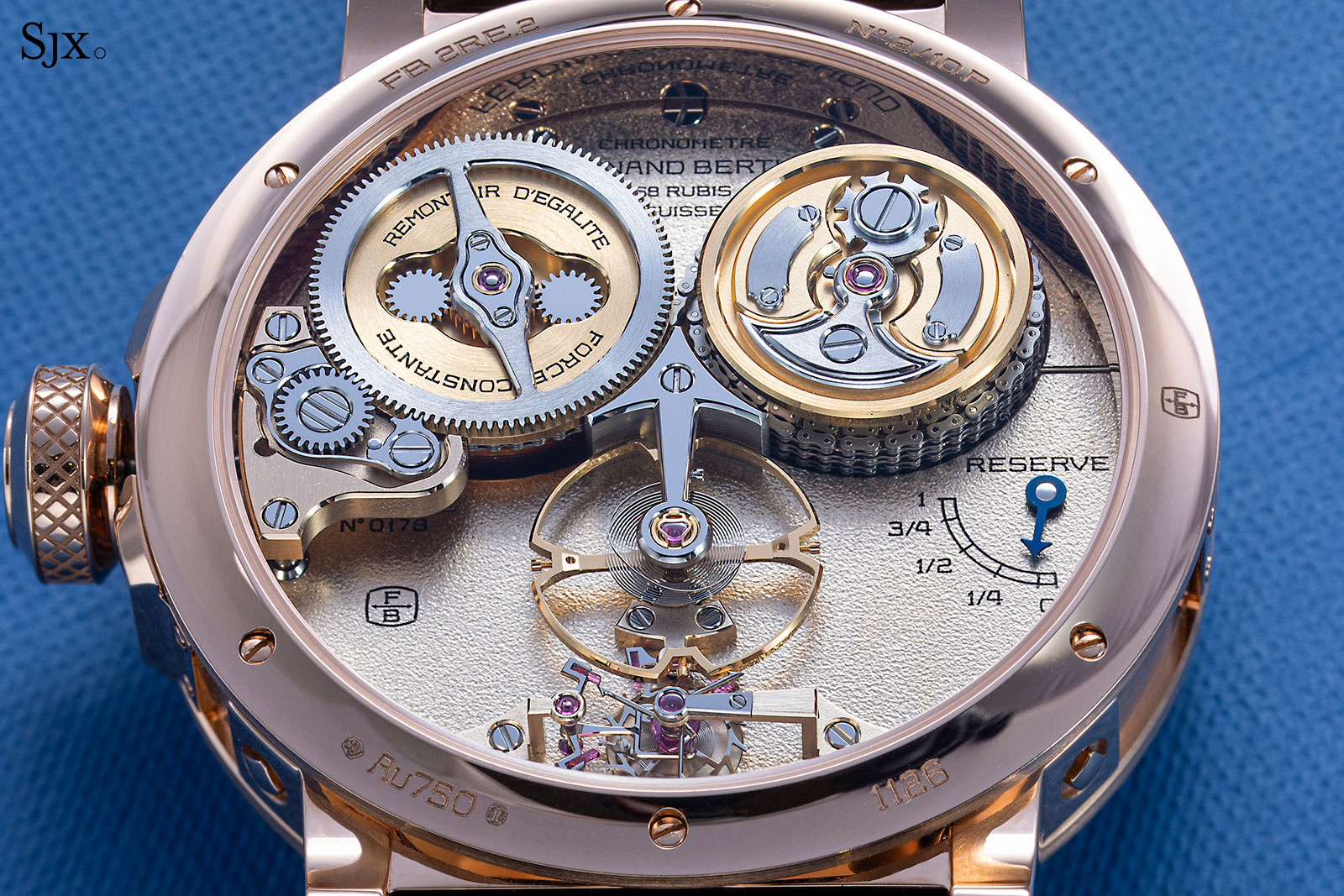
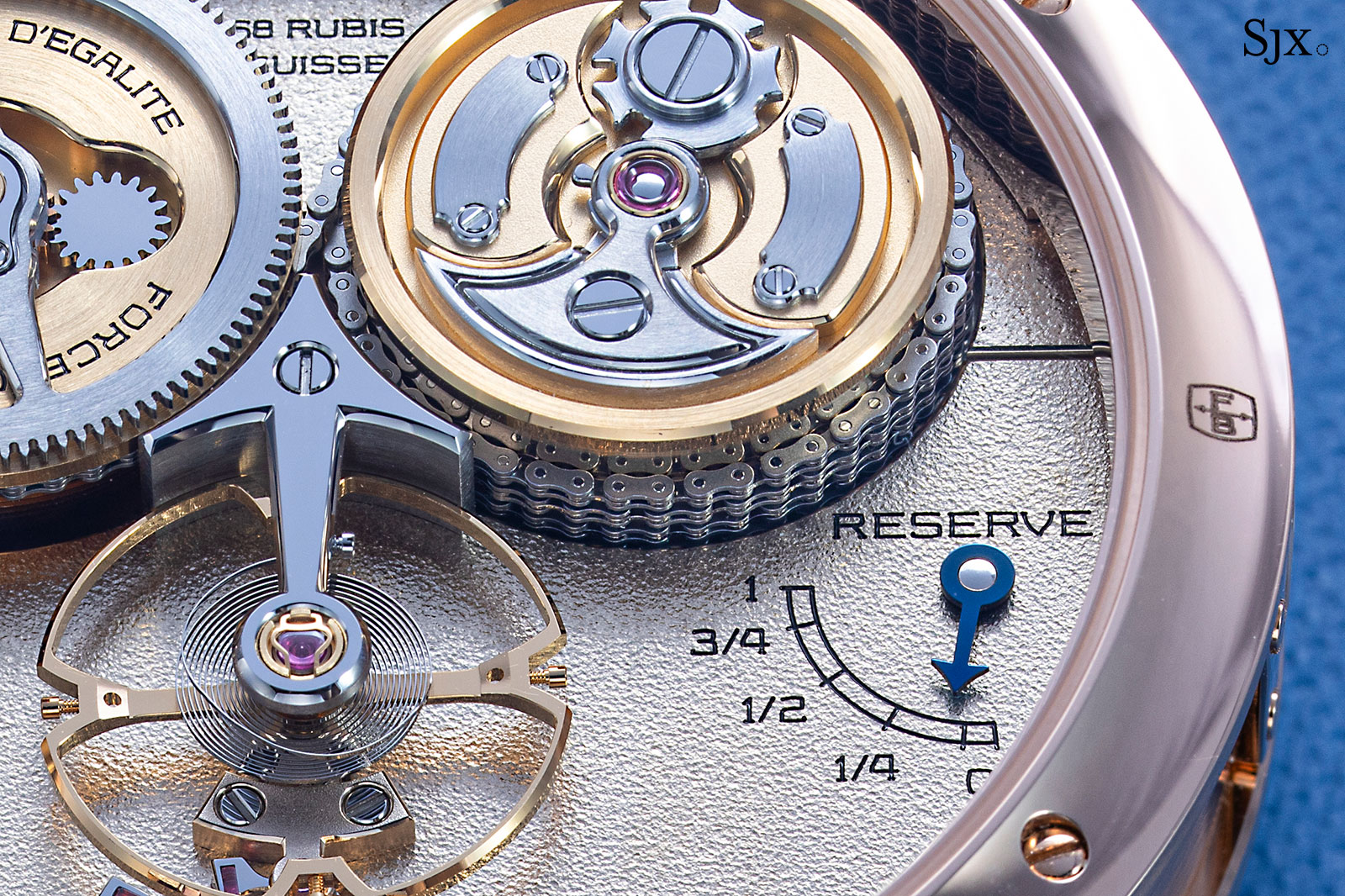
Though the chain and fusee is an ancient invention, and found in several wristwatches, the construction of the mechanism in the FB-RE.FC is unusual. A construction that’s been patented by Ferdinand Berthoud, the chain and fusee are “floating”, secured only on the underside to the main plate, instead on both sides as is convention.
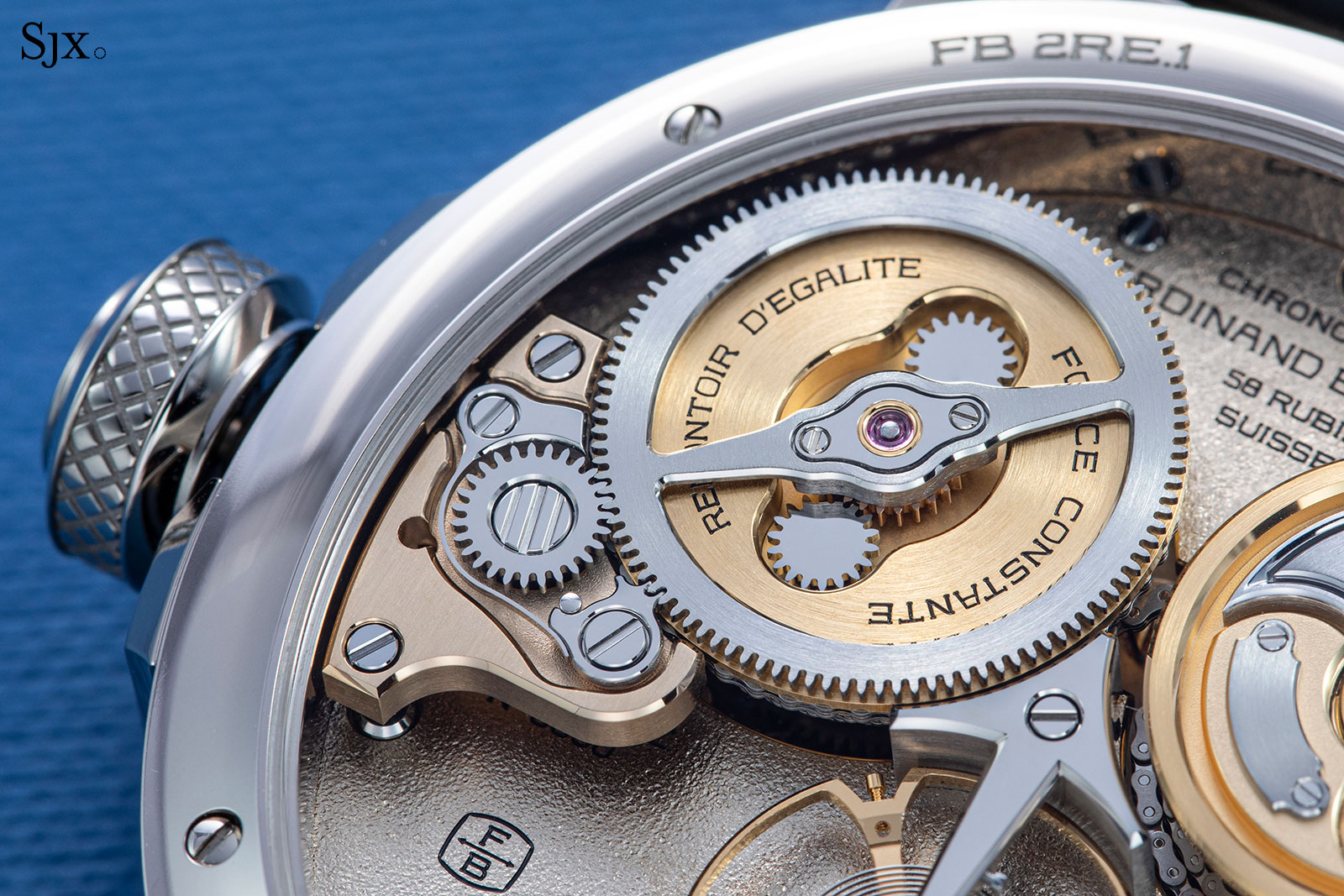
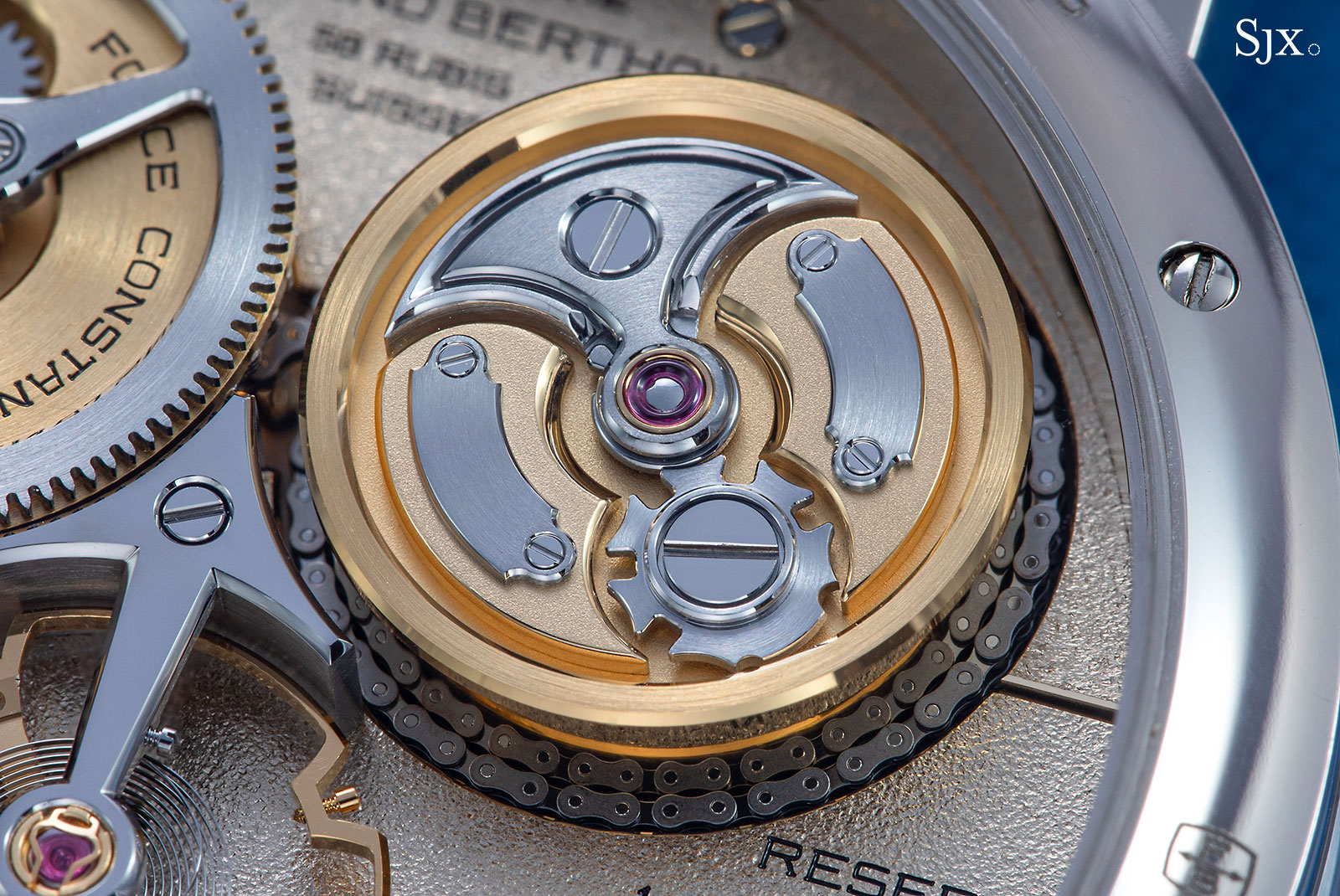
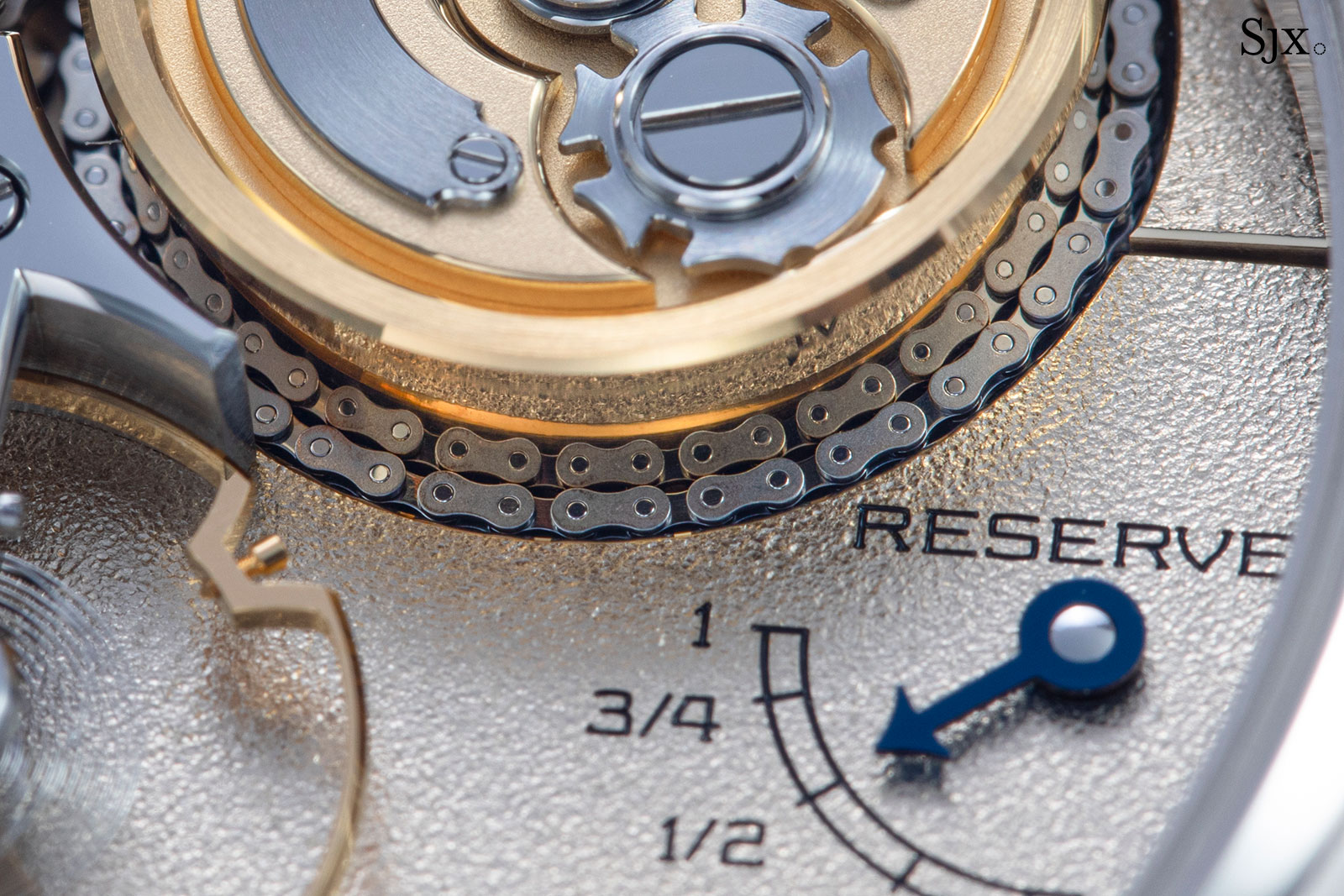
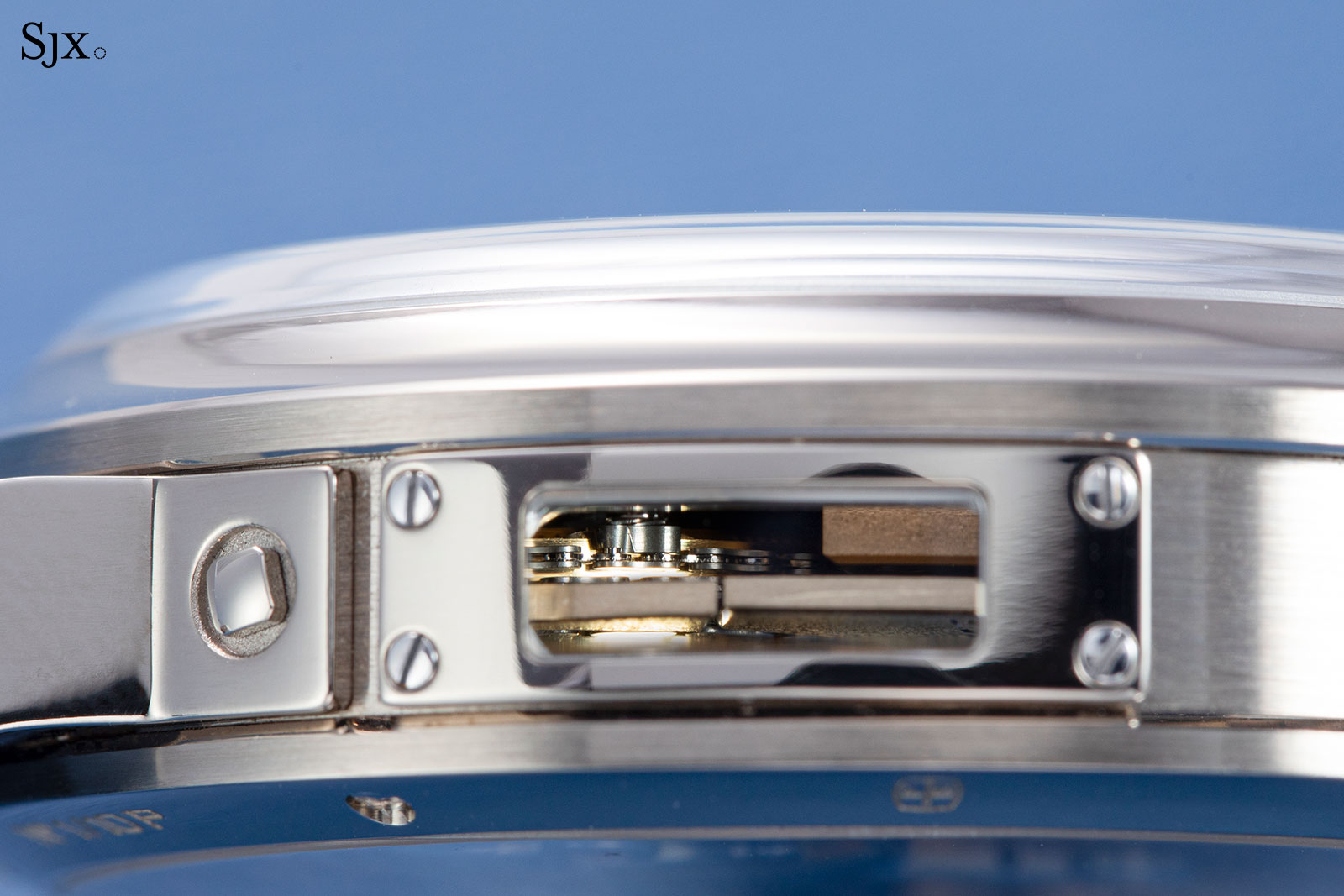
A porthole on the case reveals part of the chain
The other patent in the barrel set up is the Maltese cross stop work that halts the unwinding of the mainspring at 50 hours, past which the energy supplied is no longer optimal, even with the chain and fusee and remontoir.
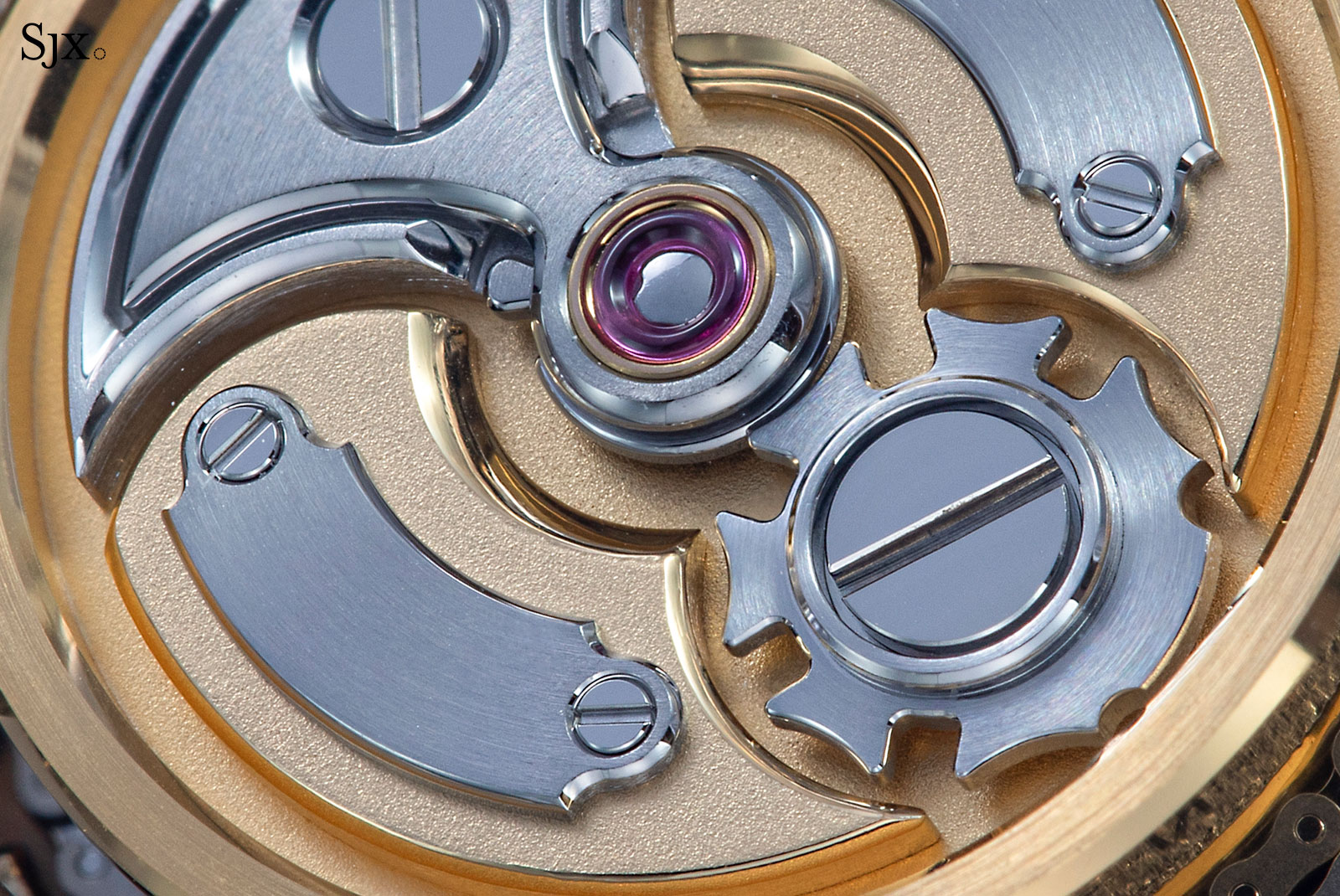
Next to the chain and fusee is the balance wheel and remontoir d’egalite. Secured by an arrow-shaped bridge, the balance wheel is large and attached to an overcoil hairspring. Right below is the constant force mechanism that is modelled on the remontoir d’egalite invented by Robert Gafner, a teacher at the watchmaking school of La Chaux-de-Fonds in the 1930s and 1940s.
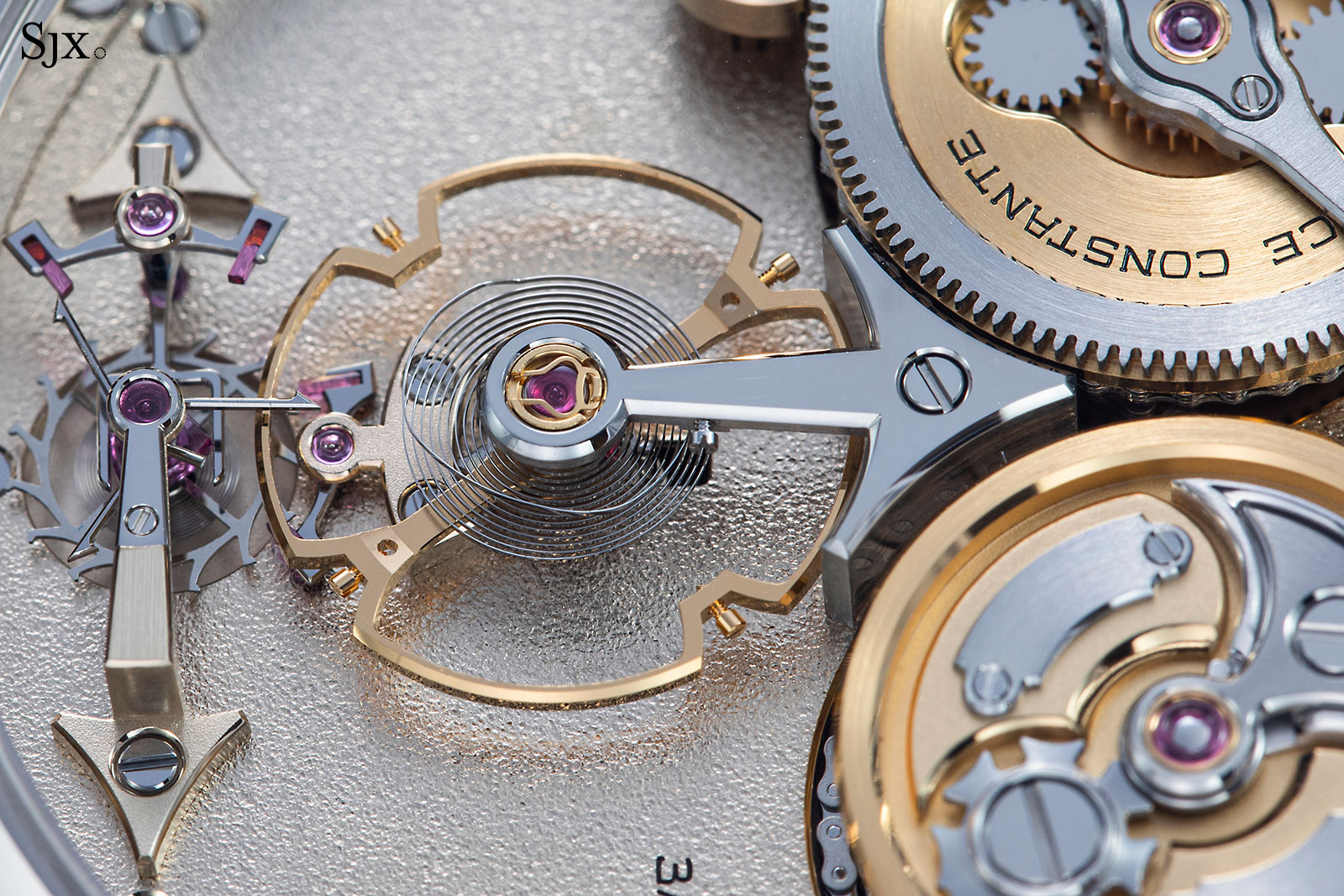
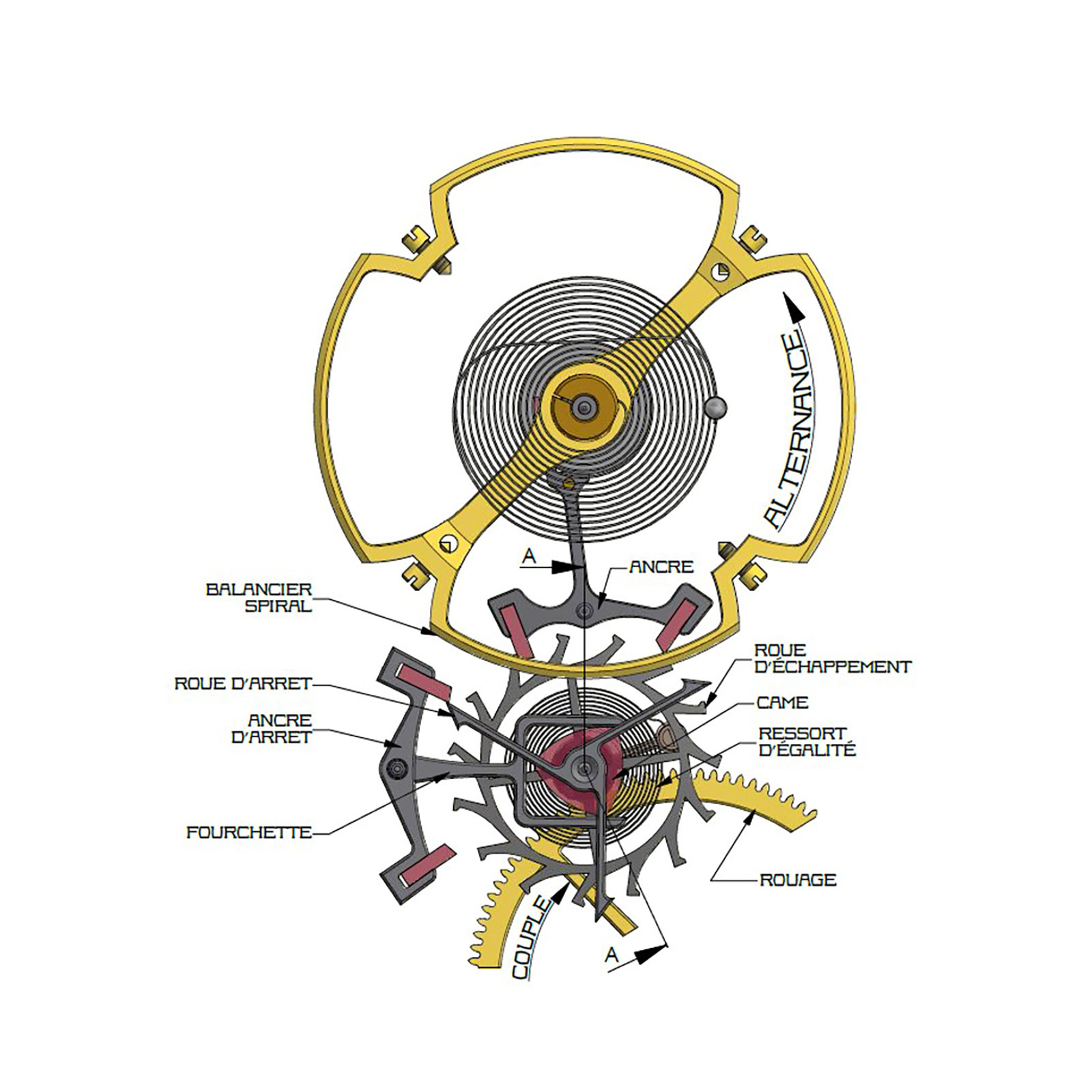
The balance and constant force mechanism. Diagram – Ferdinand Berthoud
Known as système Gafner, the constant force mechanism is centred on a ruby cam shaped like a Reuleaux triangle.
Every time the escape wheel moves 2.5 teeth forward – which takes on second – the ruby cam unlocks the remontoir, winding the remontoir spring. As the escape wheel continues forward, the remontoir then locks and the spring is unwound, and the process continues every second.
The escape wheel in turn is driven by the remontoir spring, which giving it an equal amount of energy each second, making it a true constant-force escapement.
And a secondary train connects the remontoir to the seconds hand, resulting in a deadbeat seconds hand that jumps forward in one-second steps. The choice of titanium for the seconds hand was to minimise its weight, and thus minimise the energy required to drive the hand.
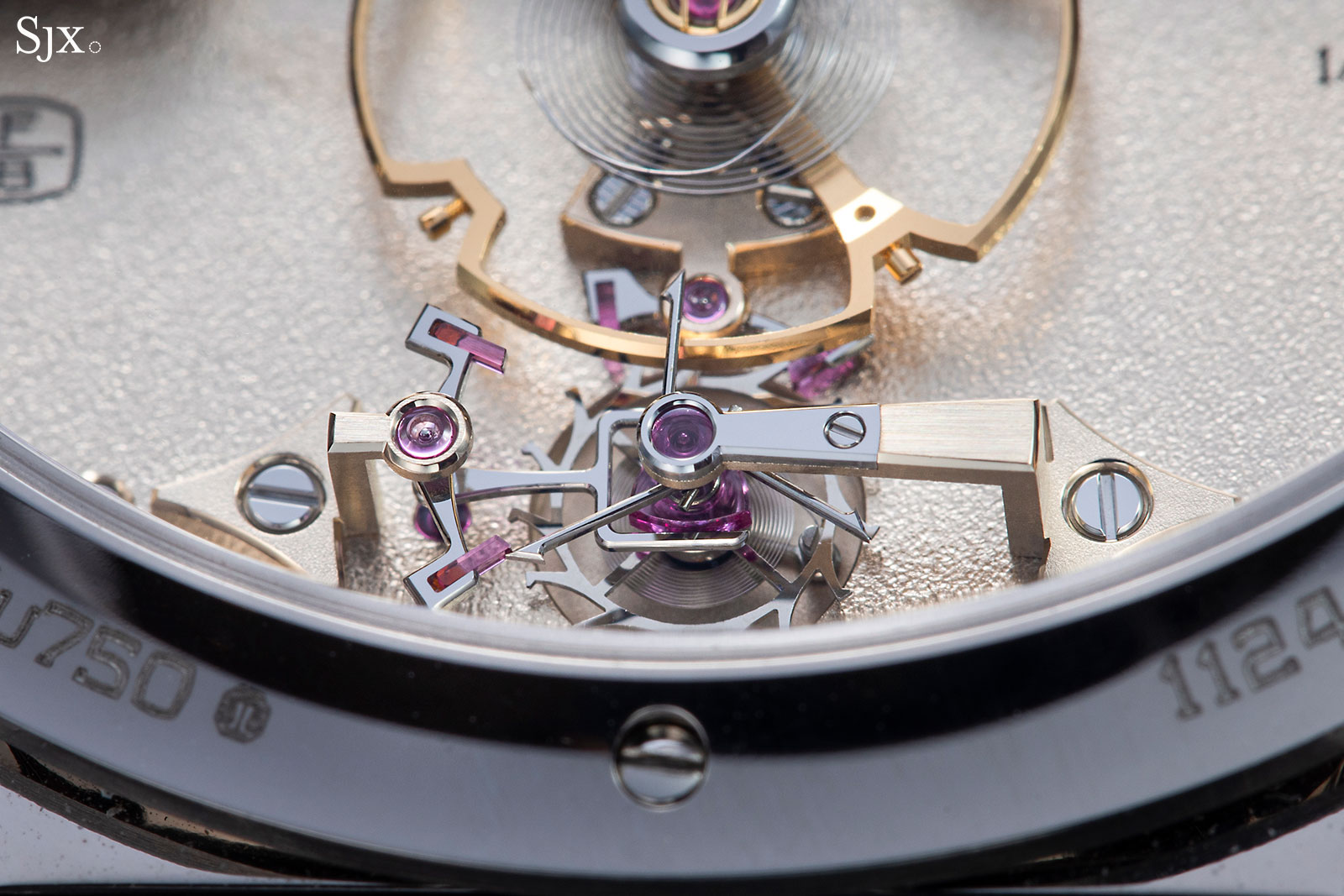
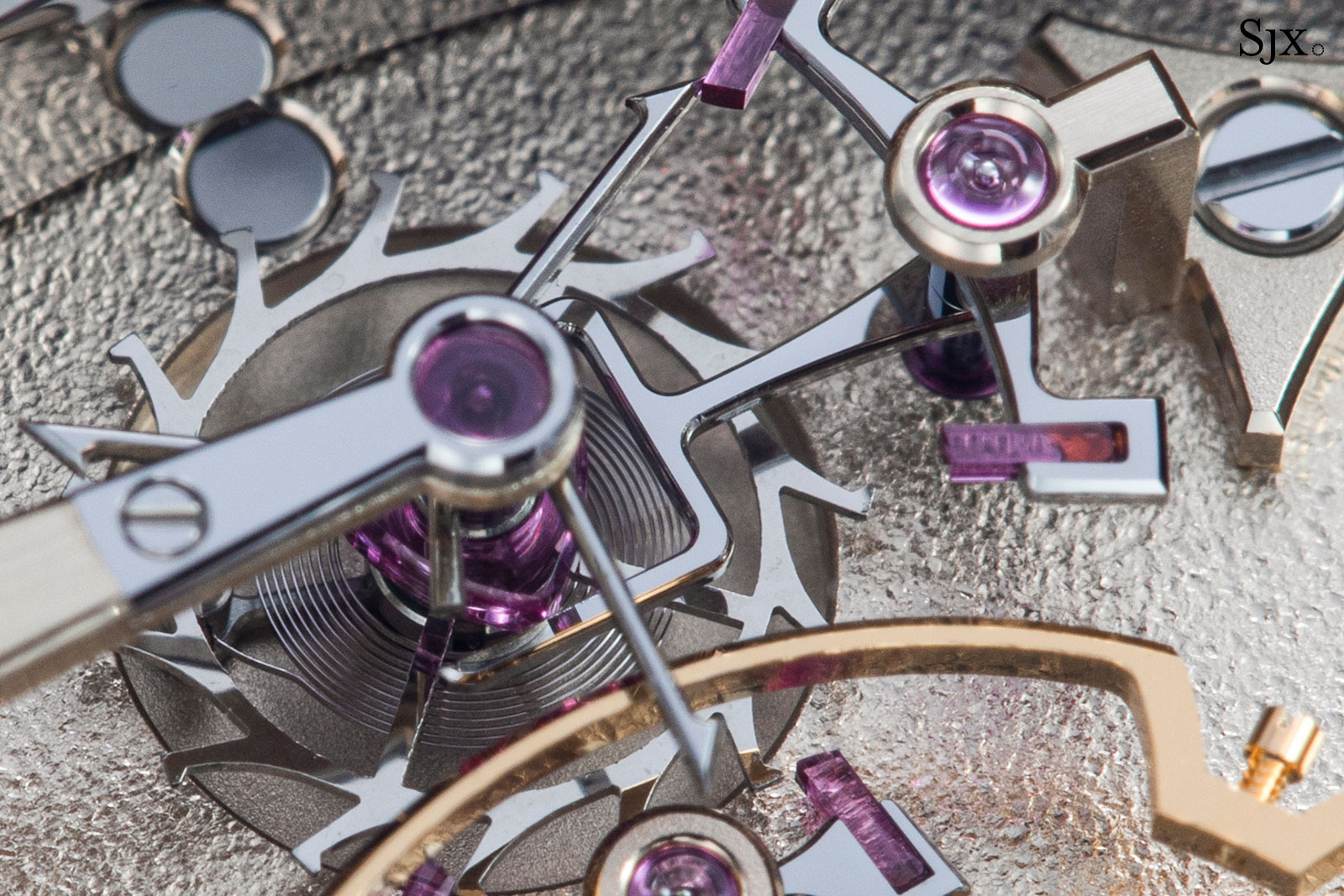
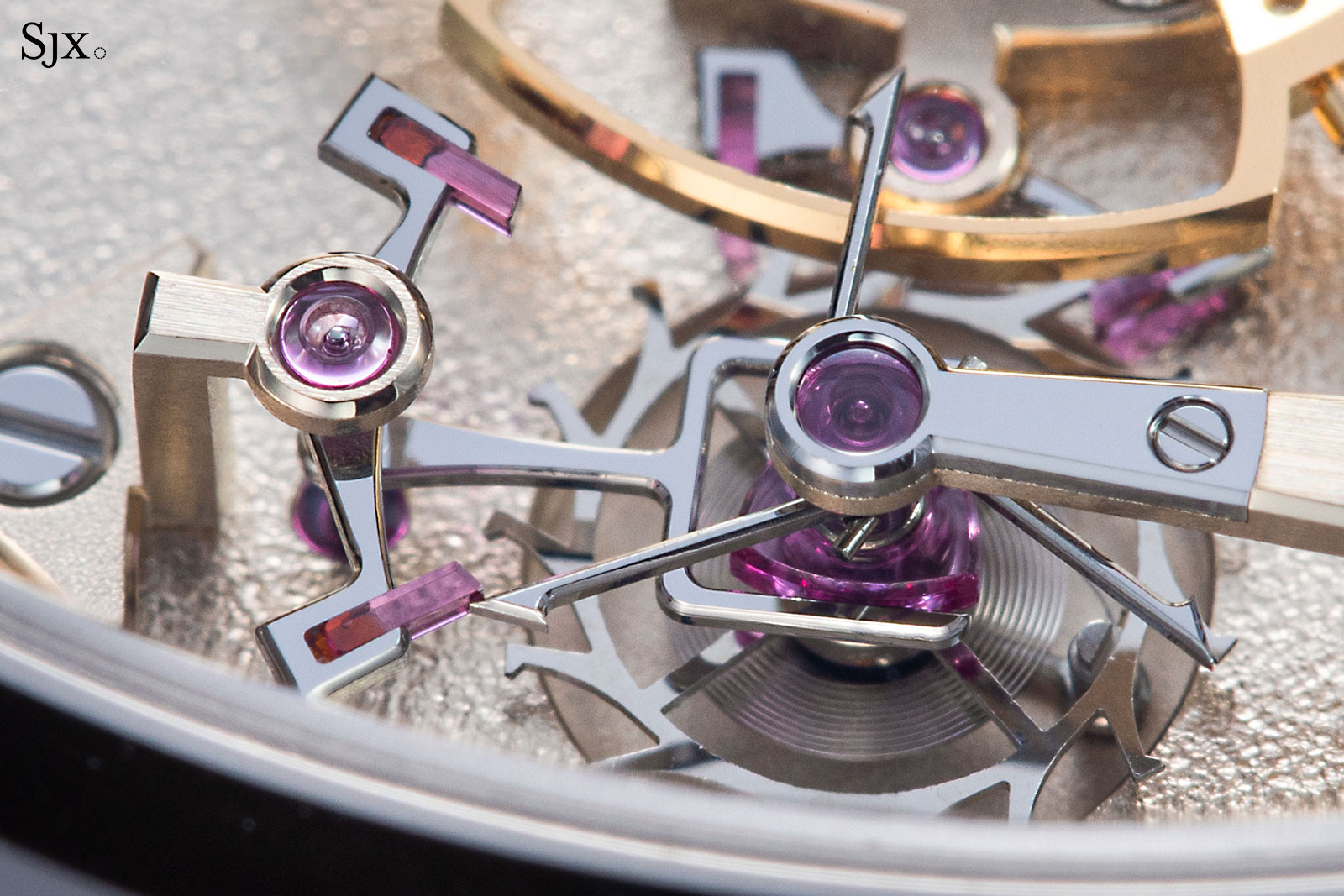
Finishing
The calibre FB-RE.FC is built with traditional materials – and finished extremely well. Ferdinand Berthoud claims “quality control of [the finishing] is carried out under a much higher degree of magnification than is customary in watchmaking, using a 6.7x magnifying glass”. And I believe it.
In fact, the finishing of some components is so fine that it is comparable to the work of artisanal independent watchmakers. This is especially true for the parts that make up the constant-force mechanism, including the three-armed stop wheel for the remontoir.
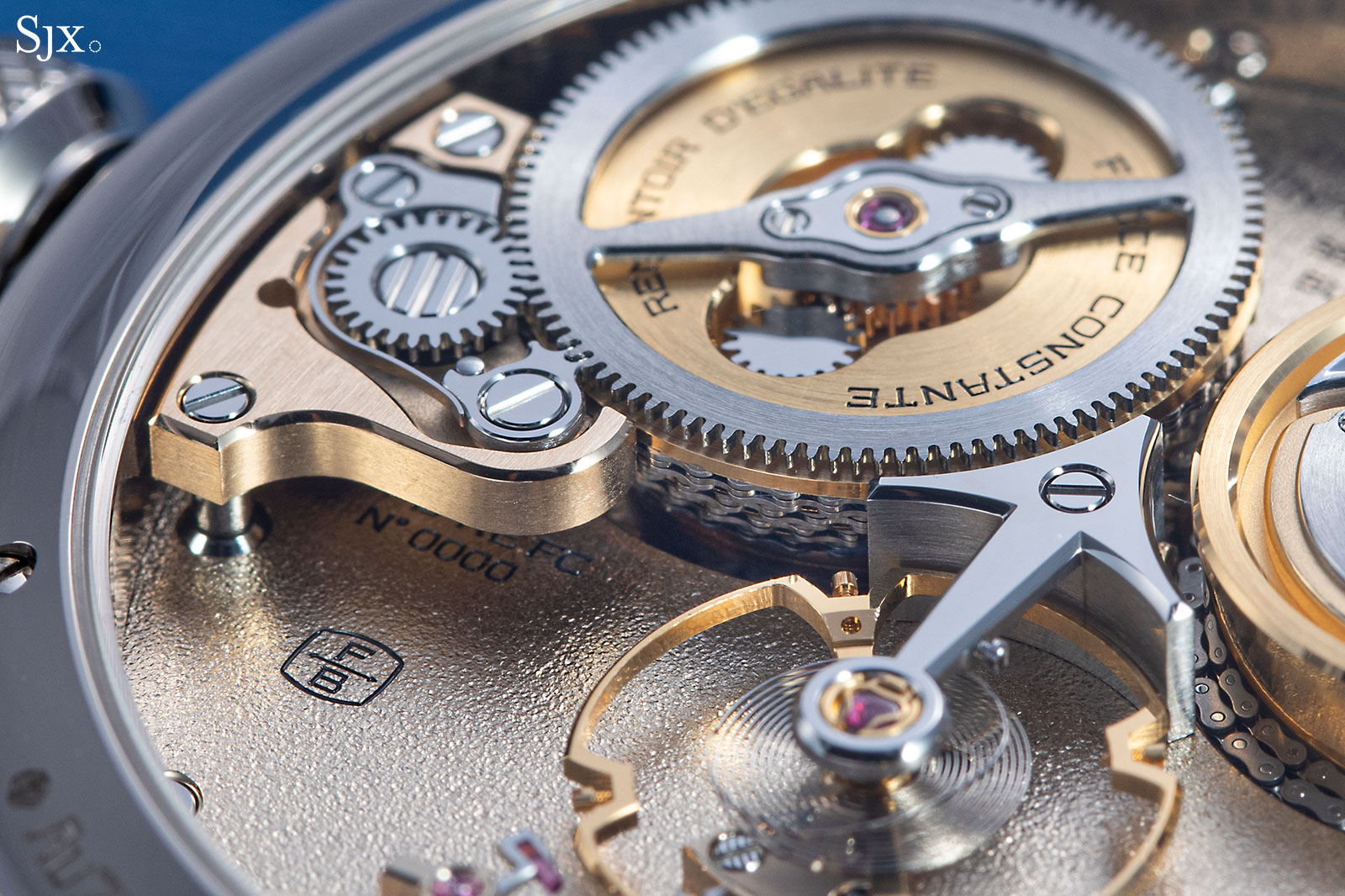

The plates and bridges are German silver that’s been frosted with a wire brush, resulting in a granular, slightly reflective surface
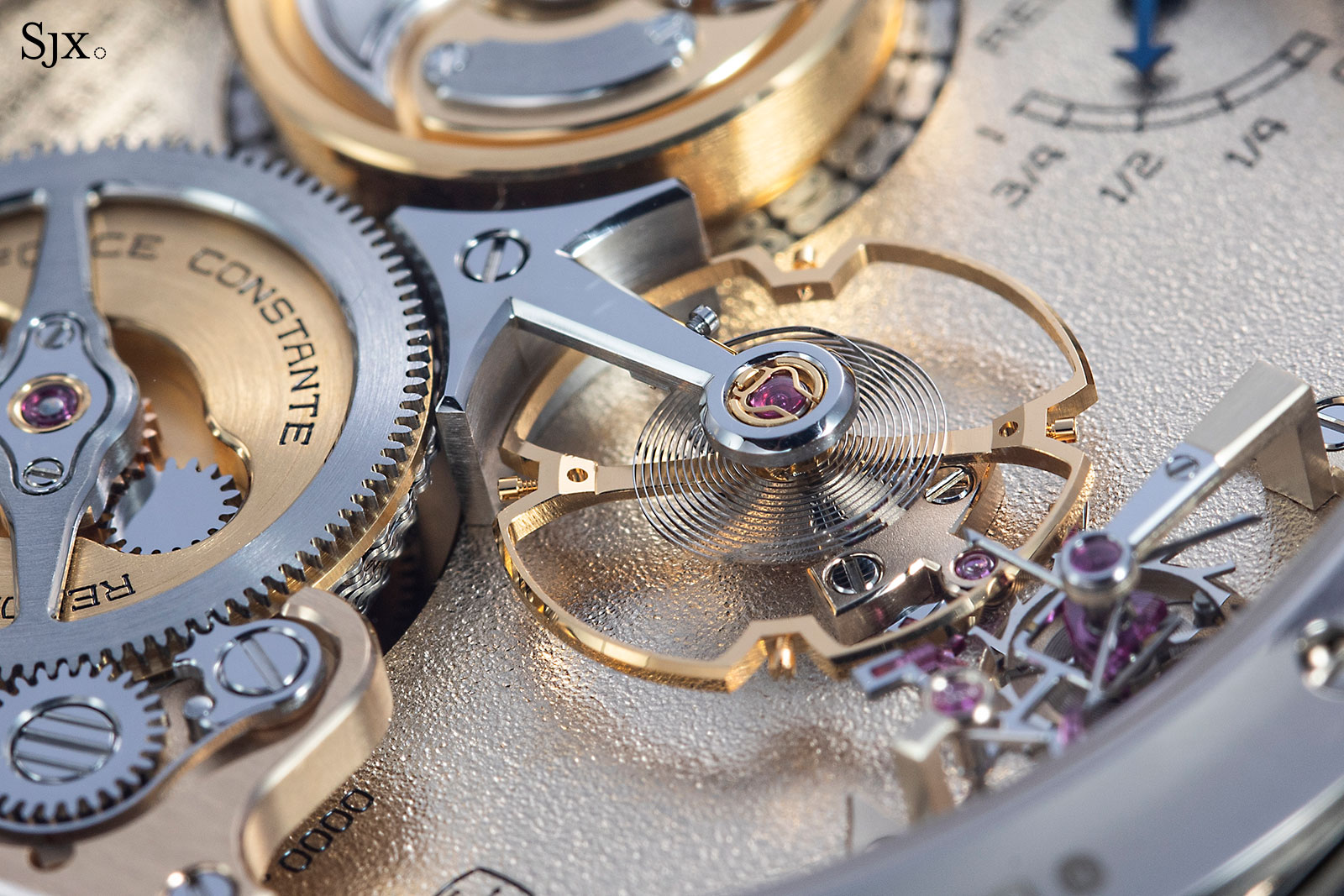
The arrow-shaped balance cock is black polished, with mirror-polished bevels and twin corners on each point of the base, making for a total of six outward angles and four inward angles on the anglage
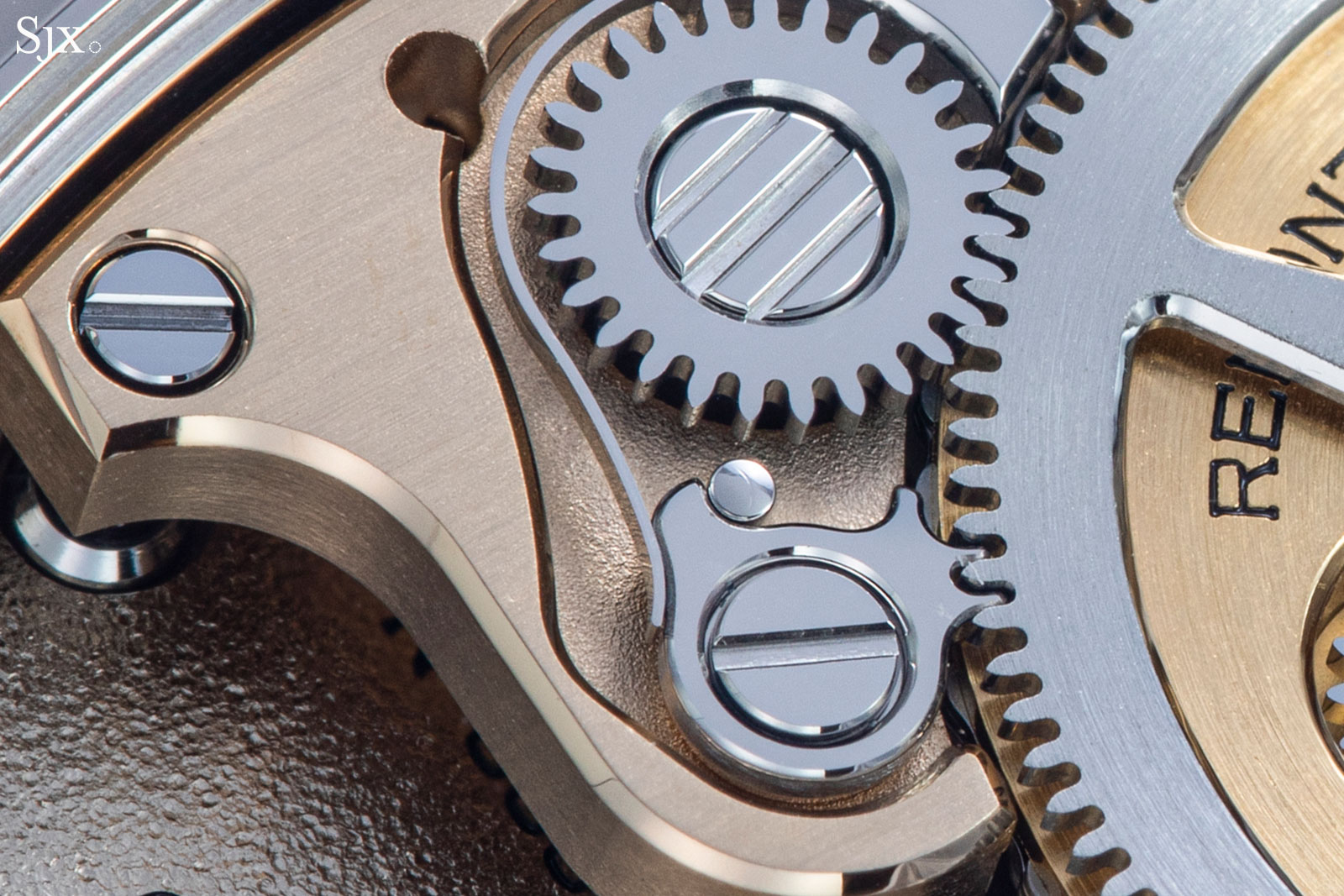
The finishing of the winding click and its spring are perfect – notice the bevelling on the minuscule teeth of the click
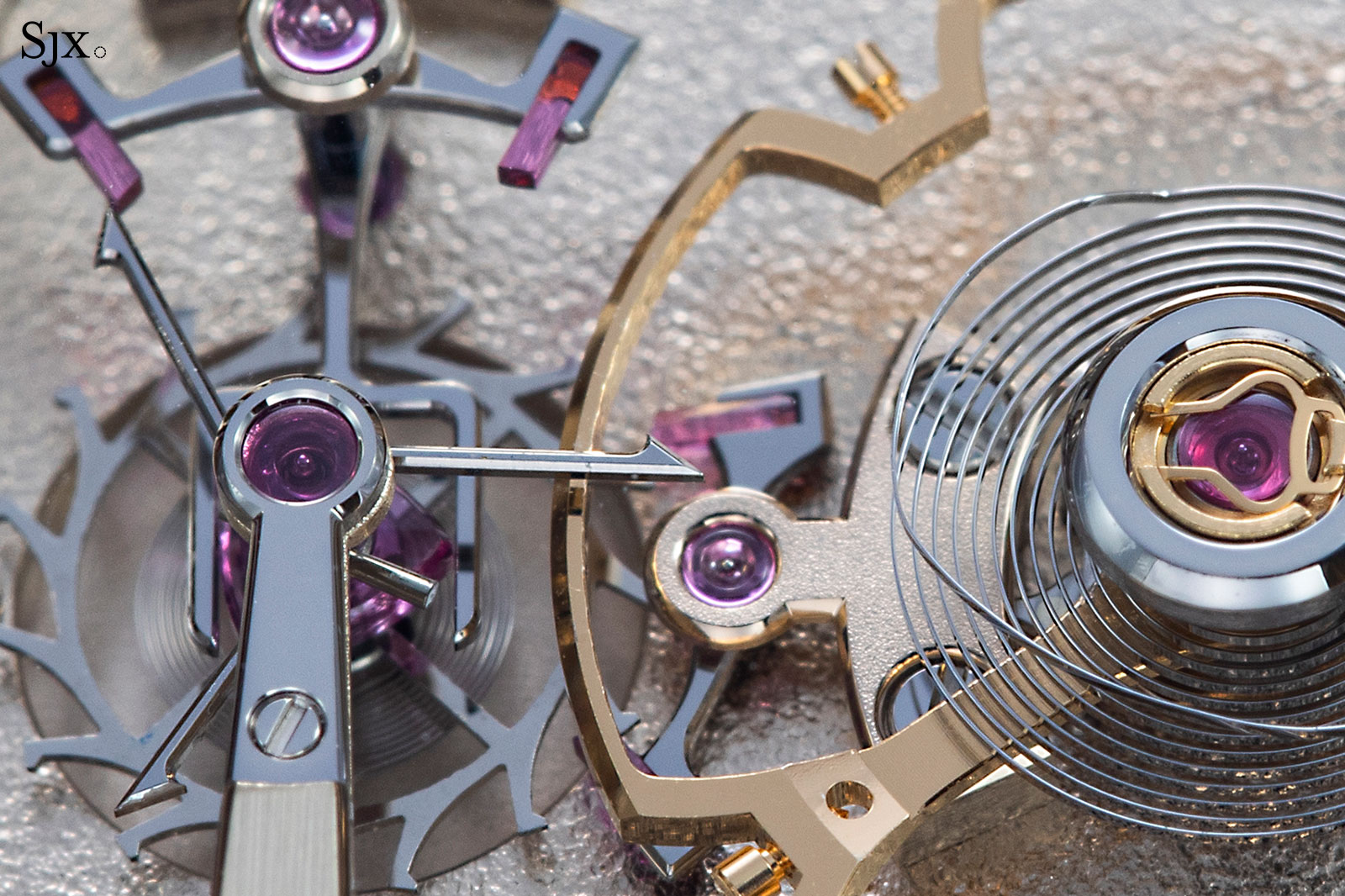
The three-armed, steel stop wheel for the remontoir is incredibly fine, yet it has polished, bevelled edges as well as piercingly sharp points on each arm
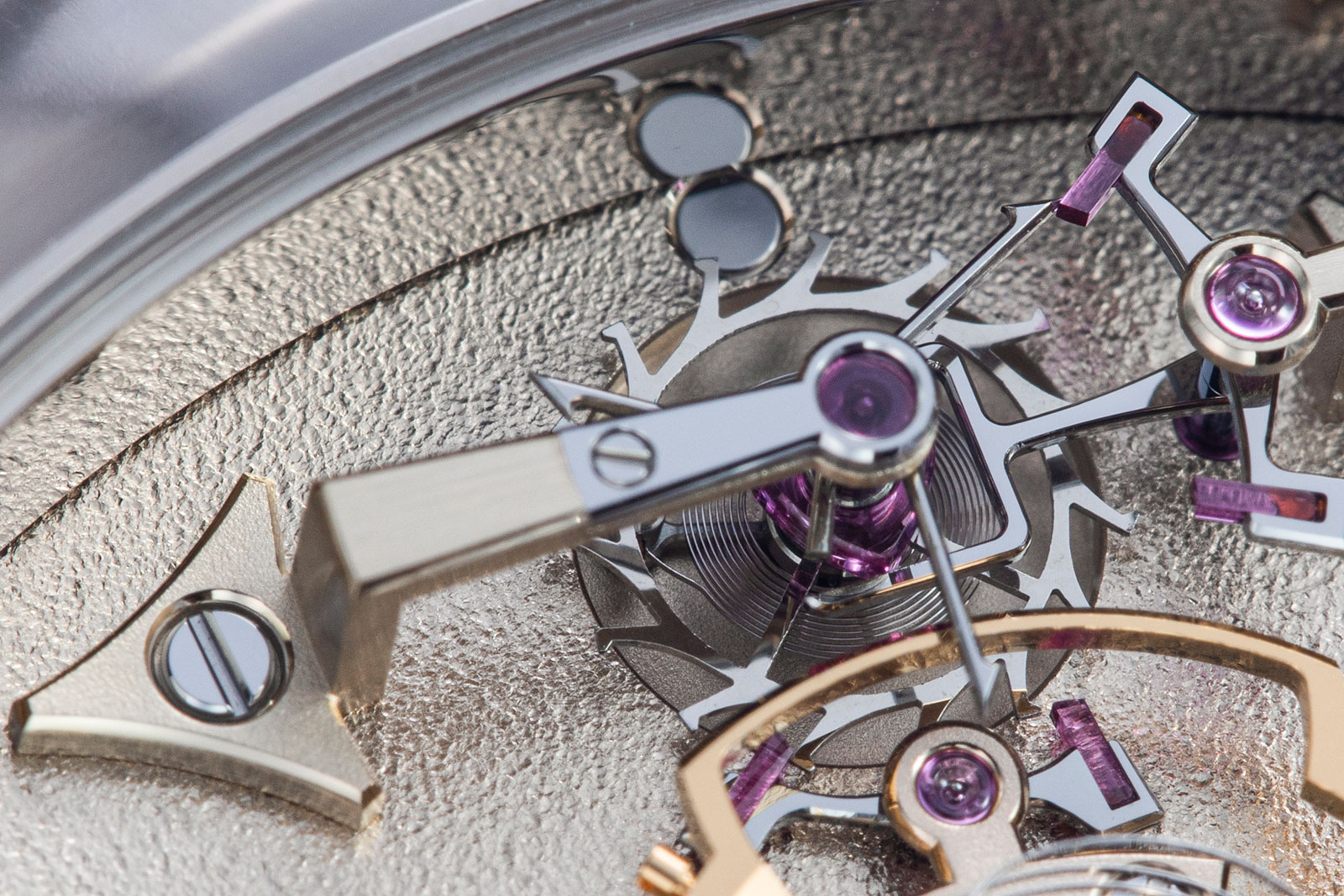
The top of the pillars that hold the plates are also mirror polished, and reflect against the mirror-finished inner wall of the case. Also note the base of the remontoir cock, which has twin corners for each point.
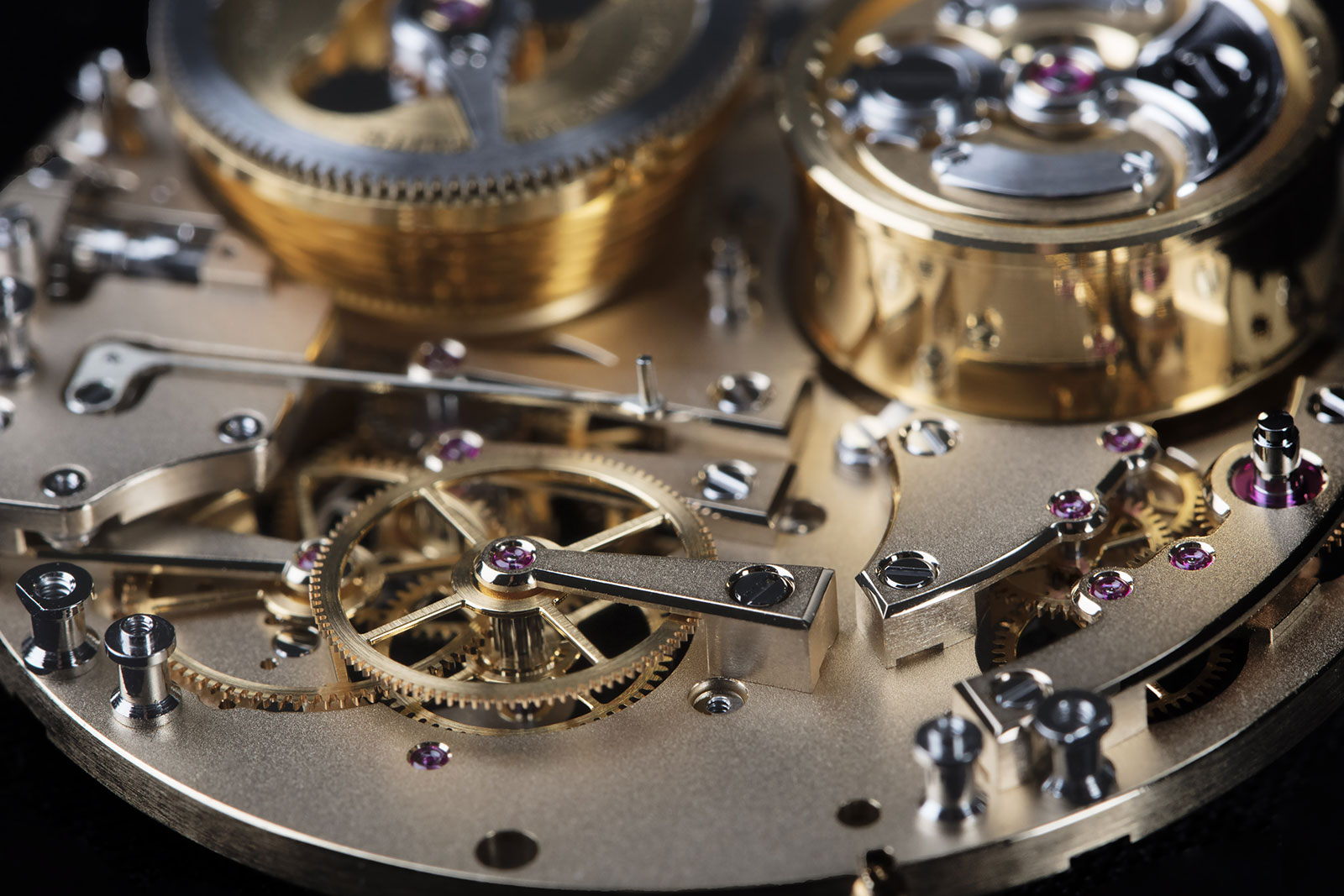
The finishing underneath the plates is similarly excellent. Image – Ferdinand Berthoud
The familiar remontoir
There is a similarity between the FB-RE.FC and the movement in the Derek Pratt wristwatch is because both were modelled on the Gafner system. Though I have yet to see the Derek Pratt watch in the metal, having seen only photos, the FB 2RE is the more compelling proposition, price aside.
That is unusual, since an independent watchmaker working on a specialised complication typically has an advantage over a mainstream brand. But in this case the FB 2RE appears to have a finer construction and a more elaborate finish. And it is also more complex, having a chain and fusee mechanism in addition to the remontoir.
At the same time, the Derek Pratt wristwatch of today is far removed from its inventor. An English watchmaker who was a contemporary of George Daniels, Pratt passed away in 2009 having never finished the wristwatch, and a number of watchmakers have since worked on the wristwatch, which has still not yet been commercialised.
Chronometry
Several weeks after the launch of the watch, Ferdinand Berthoud announced the results of the timing tests performed on the FB 2RE. First, a FB-RE.FC movement sans case was testing by COSC, doubtlessly an easy test to pass.
The subsequent Fleuritest was more rigorous – a complete FB 2RE was tested – and the watch aced the trial. Developed by FQF, an independent foundation dedicated to timepiece testing, Fleuritest is a machine that simulates wear on the wrist over 24 hours, putting the watch through its paces across several positions and temperatures, as one would encounter in everyday wear.
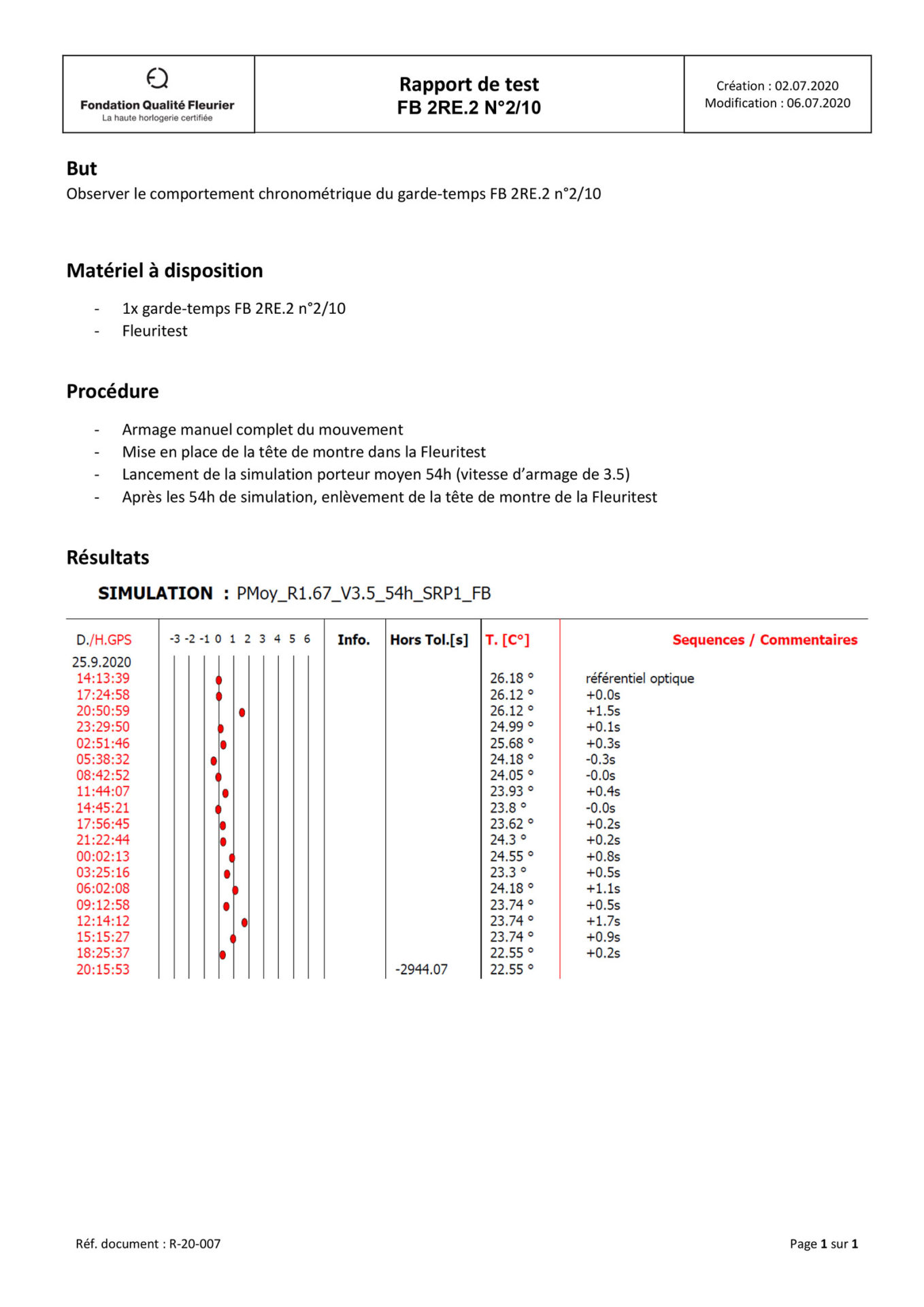
The Fleuritest report. Photo – Ferdinand Berthoud
The FB 2RE underwent the Fleuritest for 54 hours, during which its average deviation of under 0.5 seconds across the several readings taken over the 17 readings taken over the period. At the same time, the balance amplitude remained constant and strong, averaging 301 degrees.
In short, the FB 2RE is a tremendously capable timekeeper.
Variants
The FB 2RE is available in white or rose gold, each limited to 10 watches.
The rose gold model has the advantage of being more striking with its high-contrast, black-enamel dial, which is rare in itself since most enamel dials are white. But I prefer the clean and fuss-free look of the white gold model.
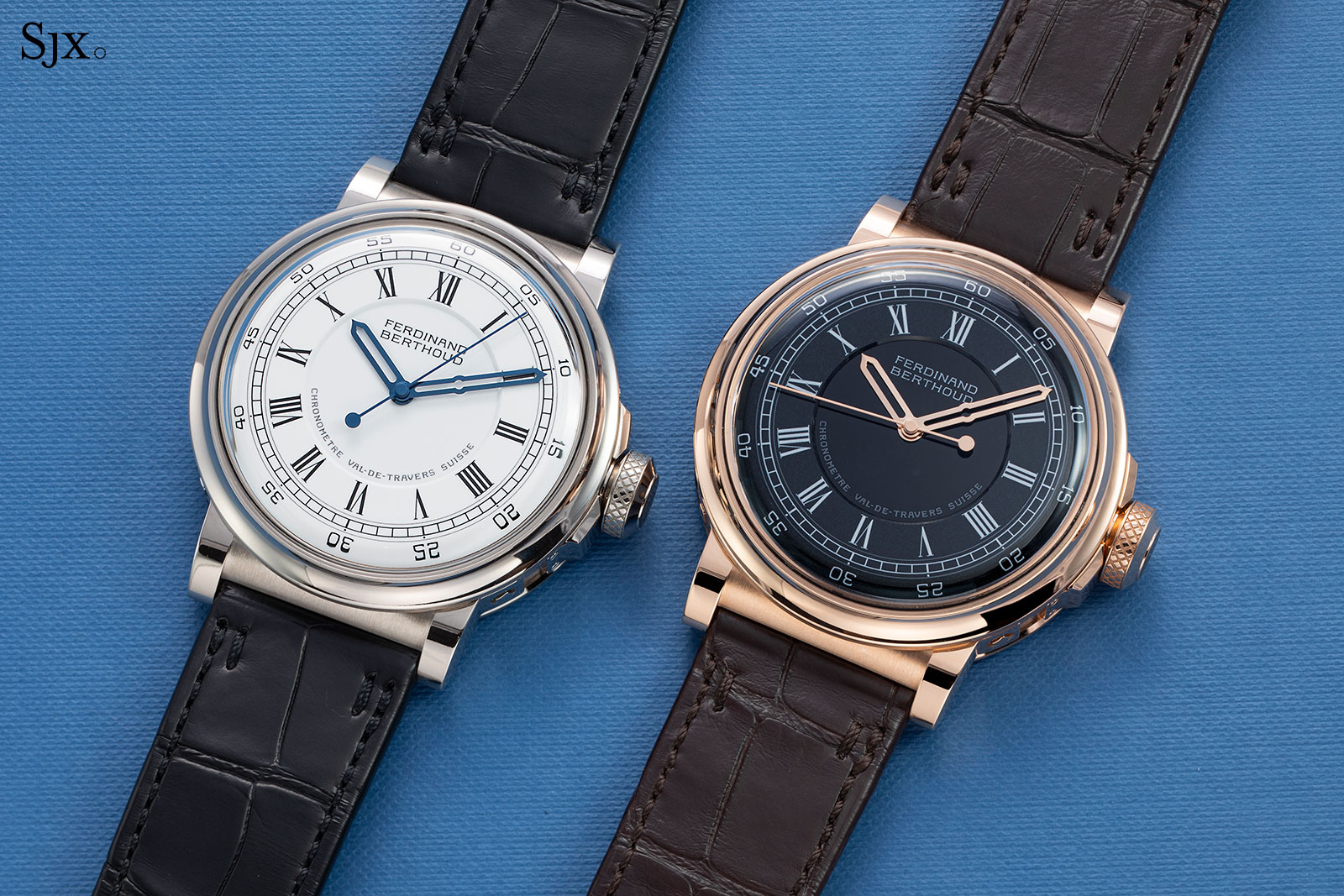
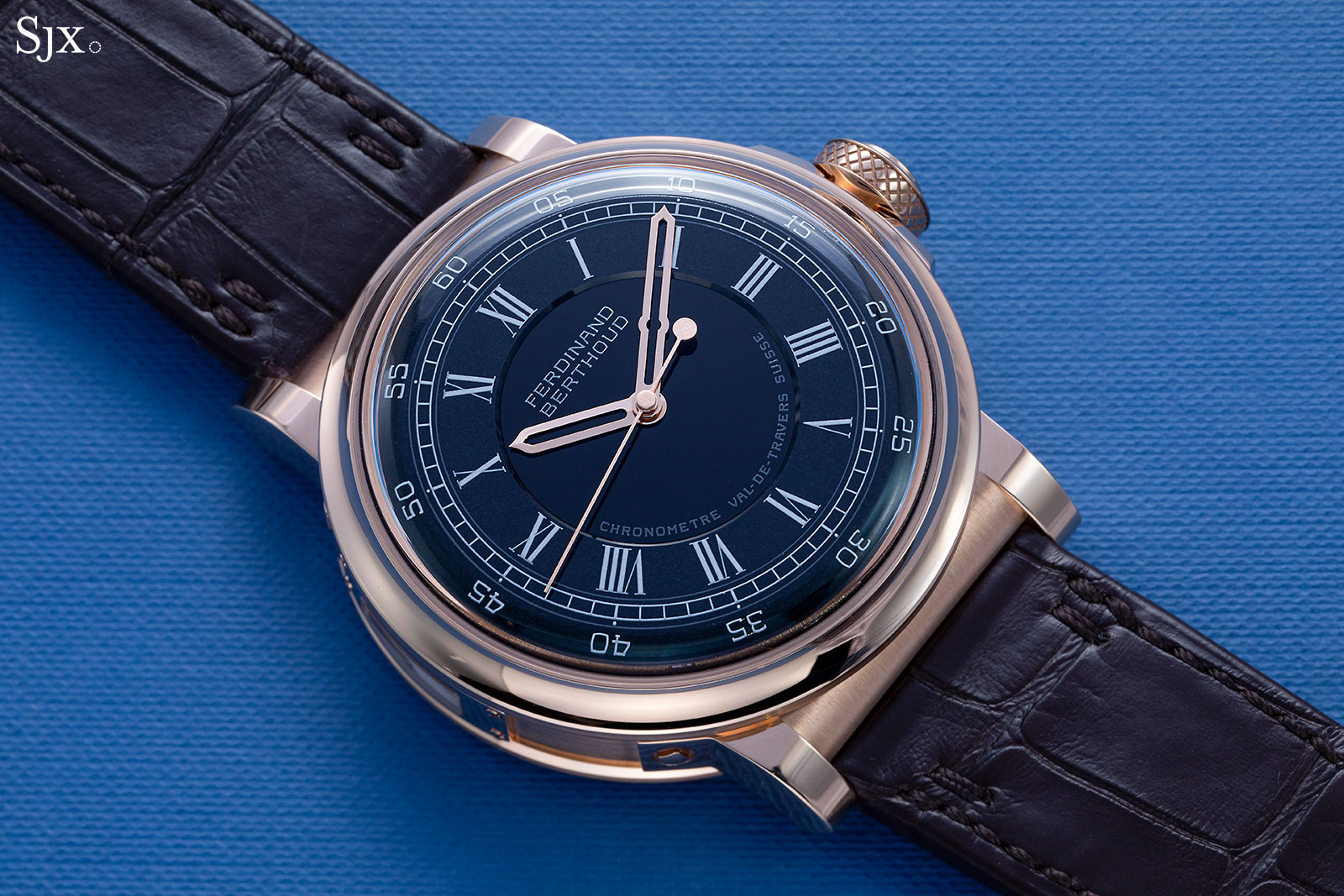
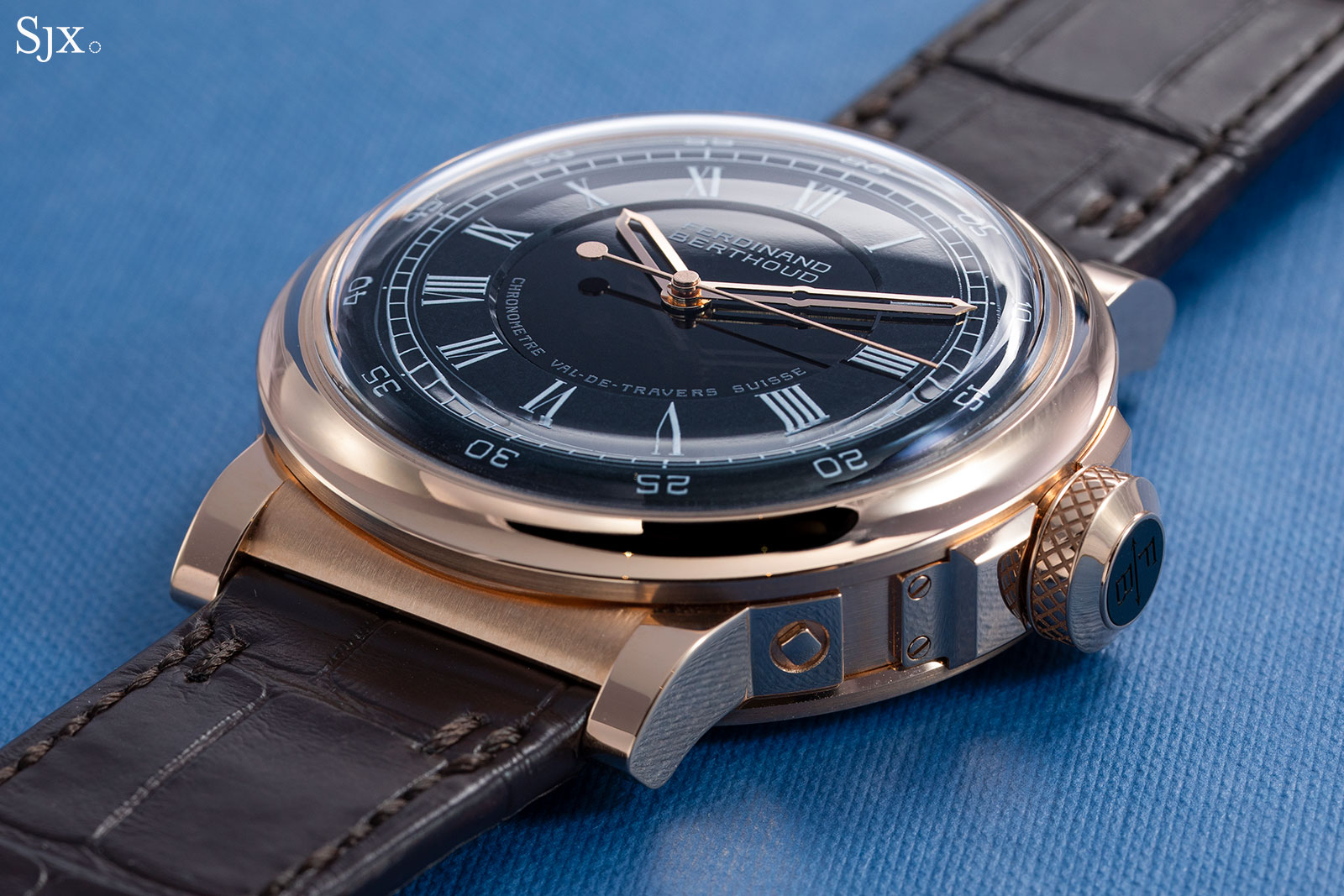
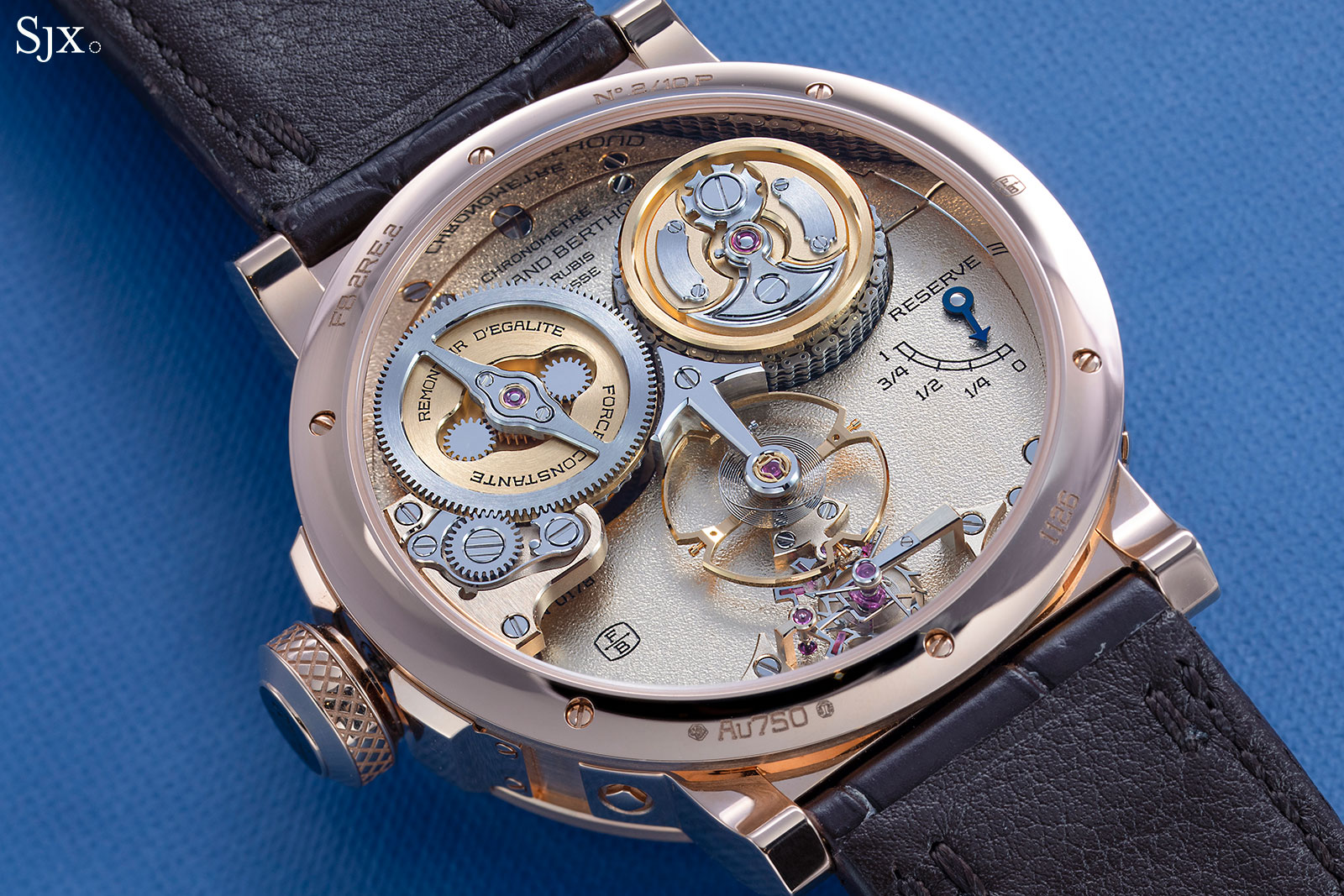
Concluding thoughts
The FB 2RE is exemplary in quality, fit, and finish. Yes, it is bit large and very expensive, but the standard of execution is astonishing. There really is little else to say.
Key Facts and Price
Ferdinand Berthoud Chronomètre FB 2RE
Ref. FB 2RE.1 (white gold)
Ref. FB 2RE.2 (rose gold)
Diameter: 44 mm
Thickness: 14.3 mm
Material: 18k rose or white gold
Crystal: Sapphire
Water resistance: 30 m
Movement: FB-RE.FC
Functions: Hours, minutes, deadbeat seconds, and power reserve indicator
Winding: Hand-wind
Frequency: 18,000 beats per hour (2.5 Hz)
Power reserve: 50 hours
Strap: Alligator with pin buckle
Limited edition: 10 pieces each in rose and white gold
Availability: At boutiques and retailers
Price: 210,000 Swiss francs; or 307,500 Singapore dollars
For more, visit Ferdinandberthoud.ch.
Updated December 31, 2020: Fleuritest results for the FB 2RE added.
Back to top.
